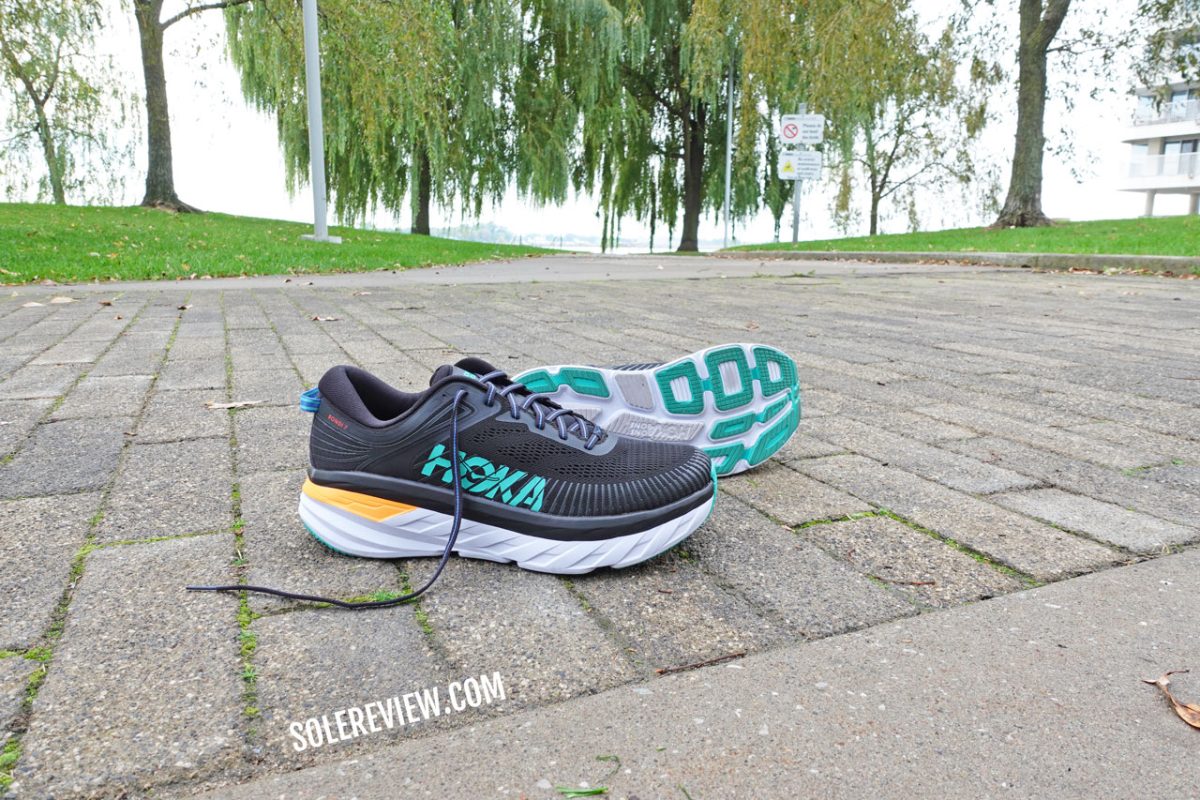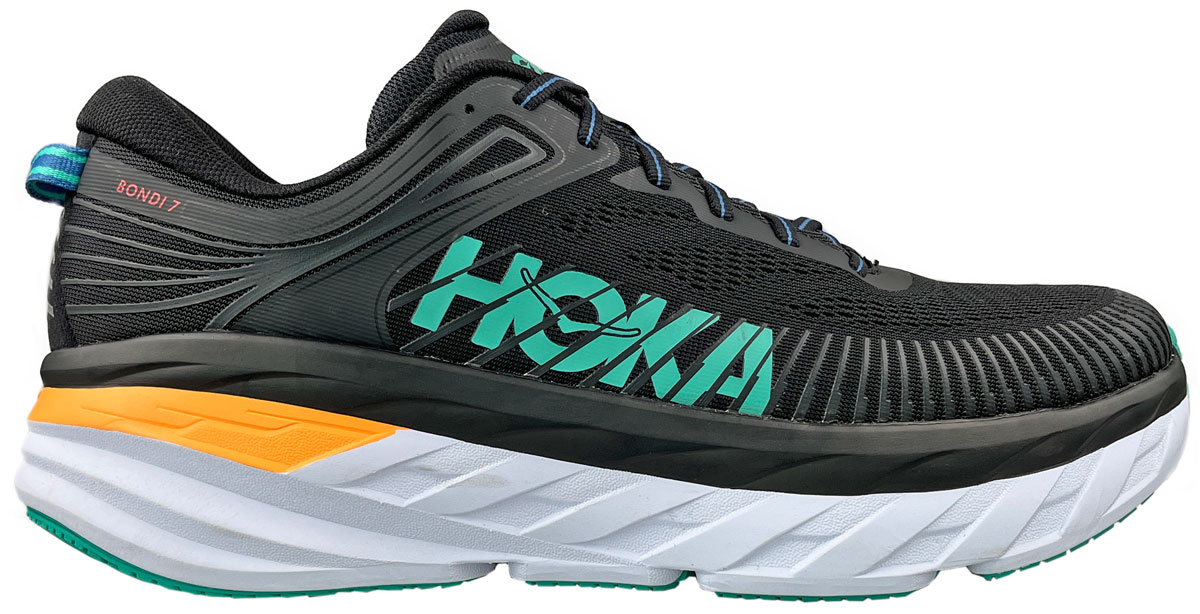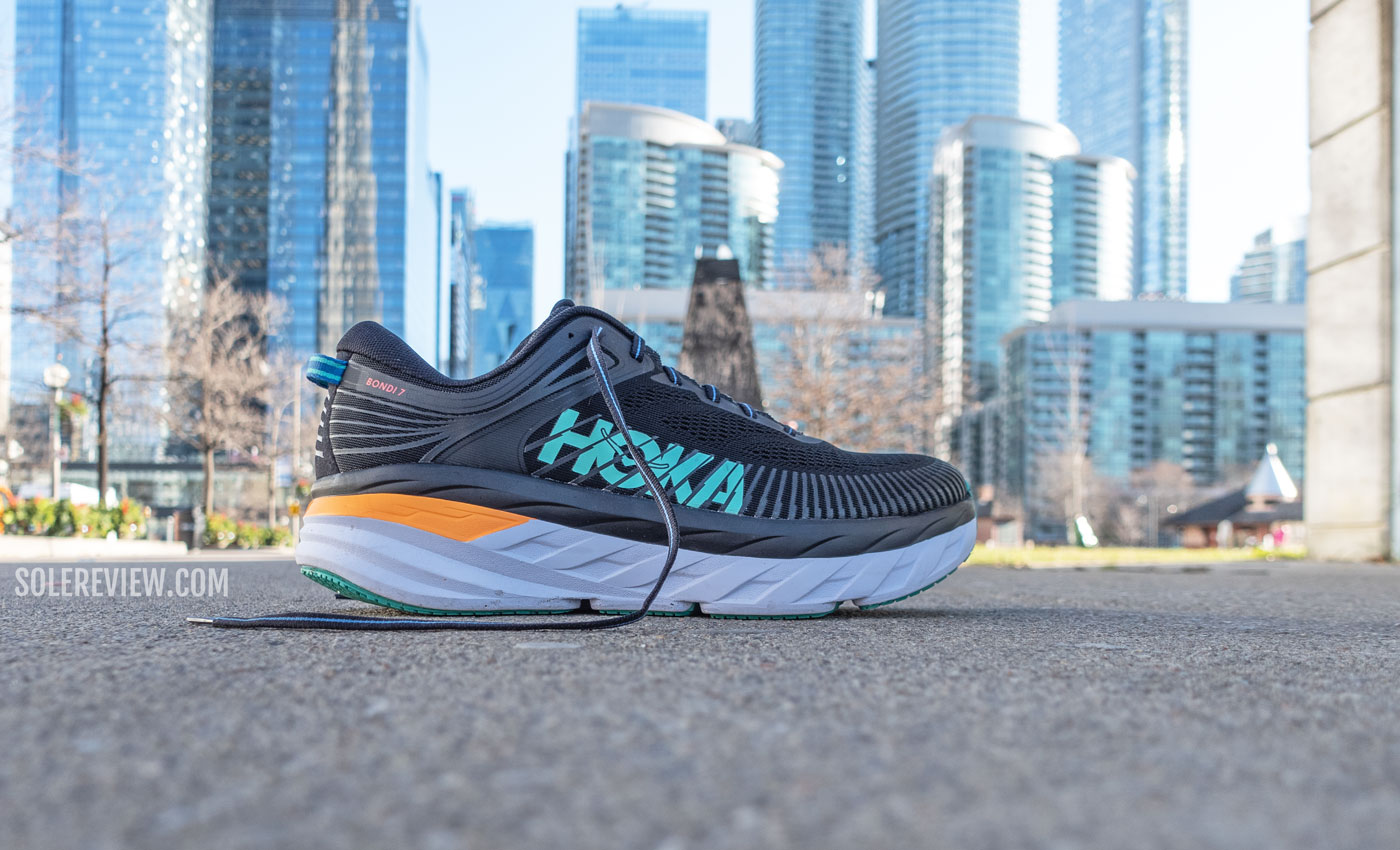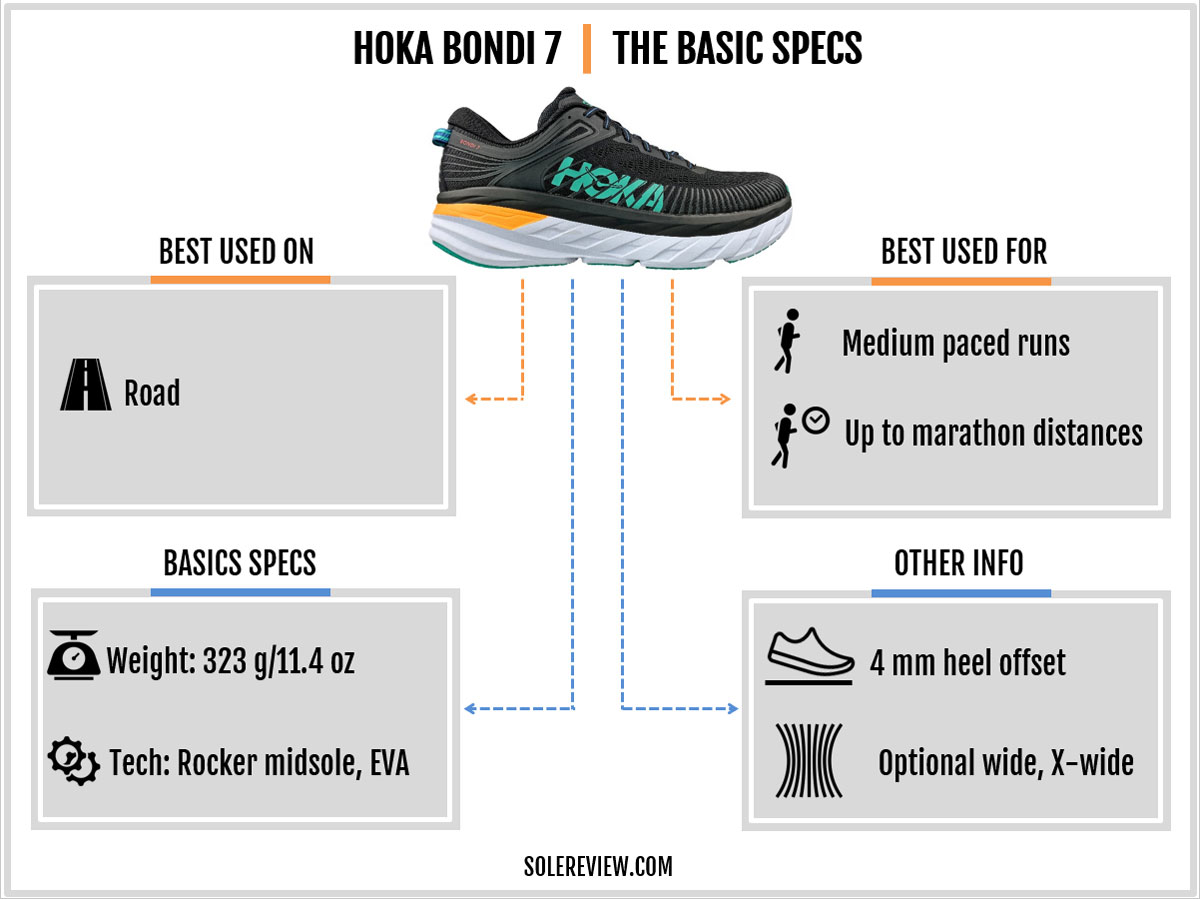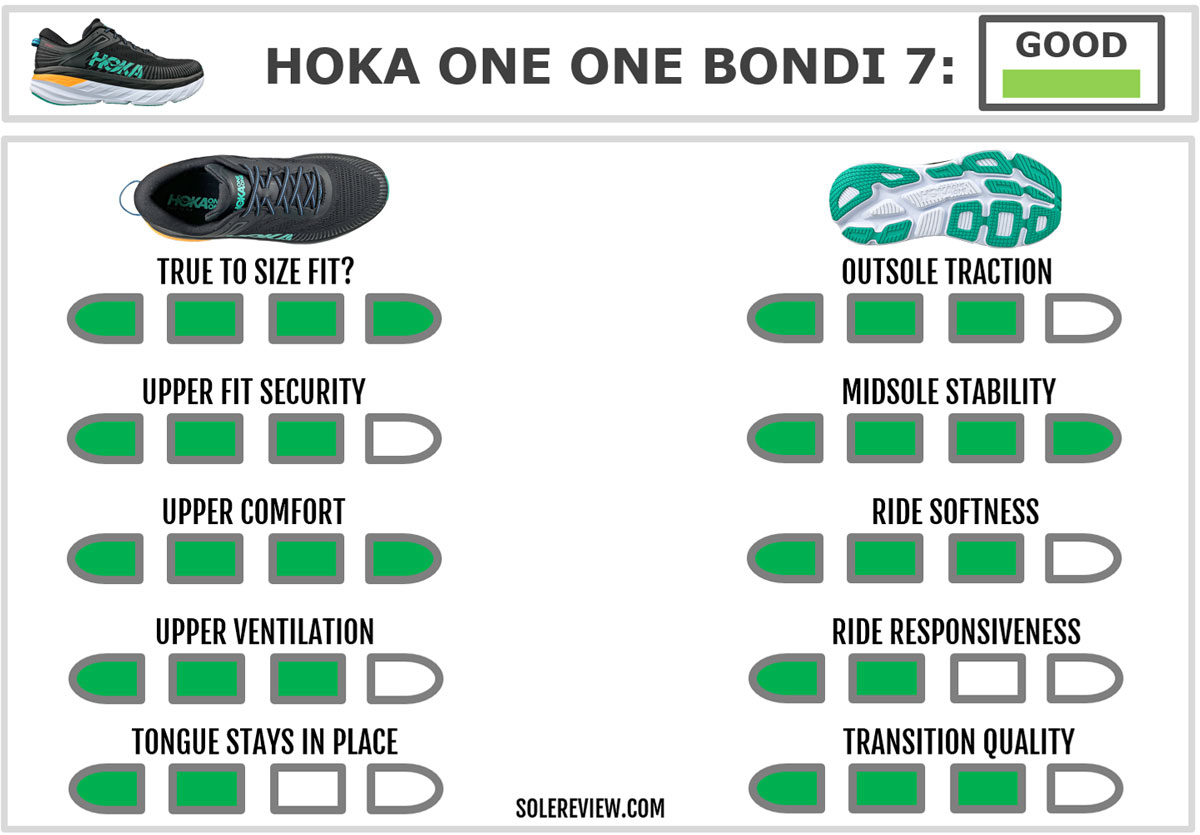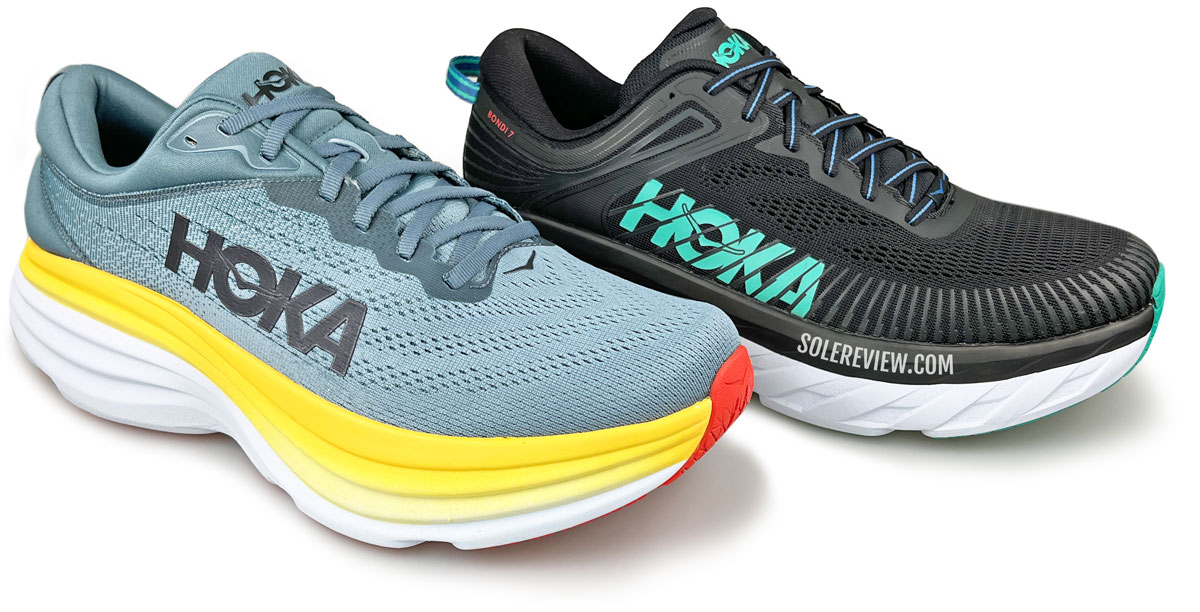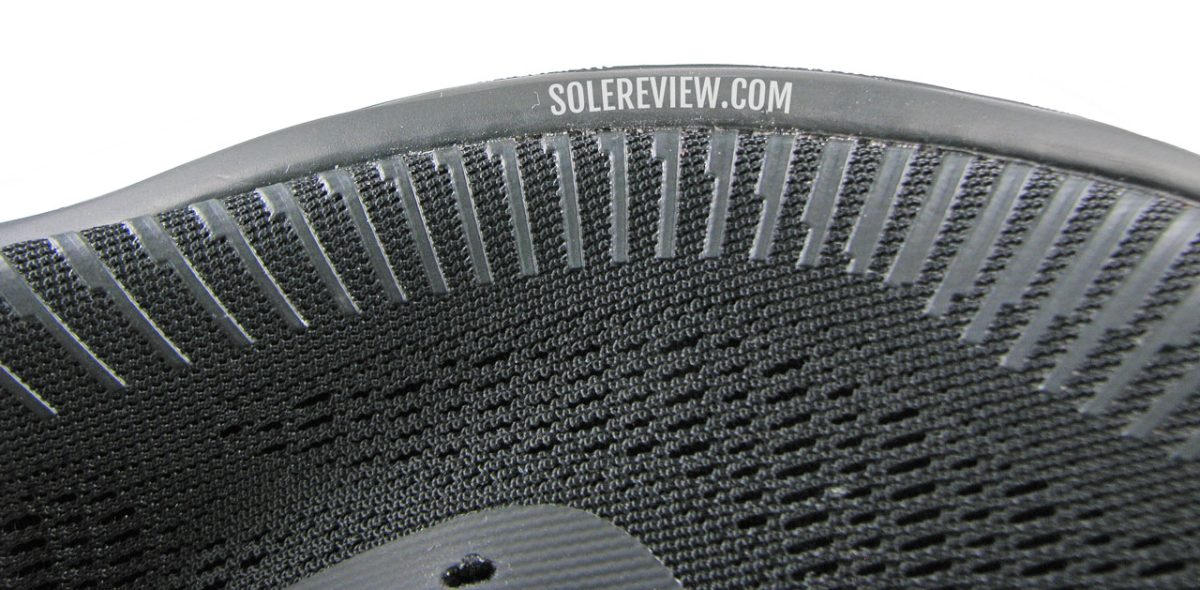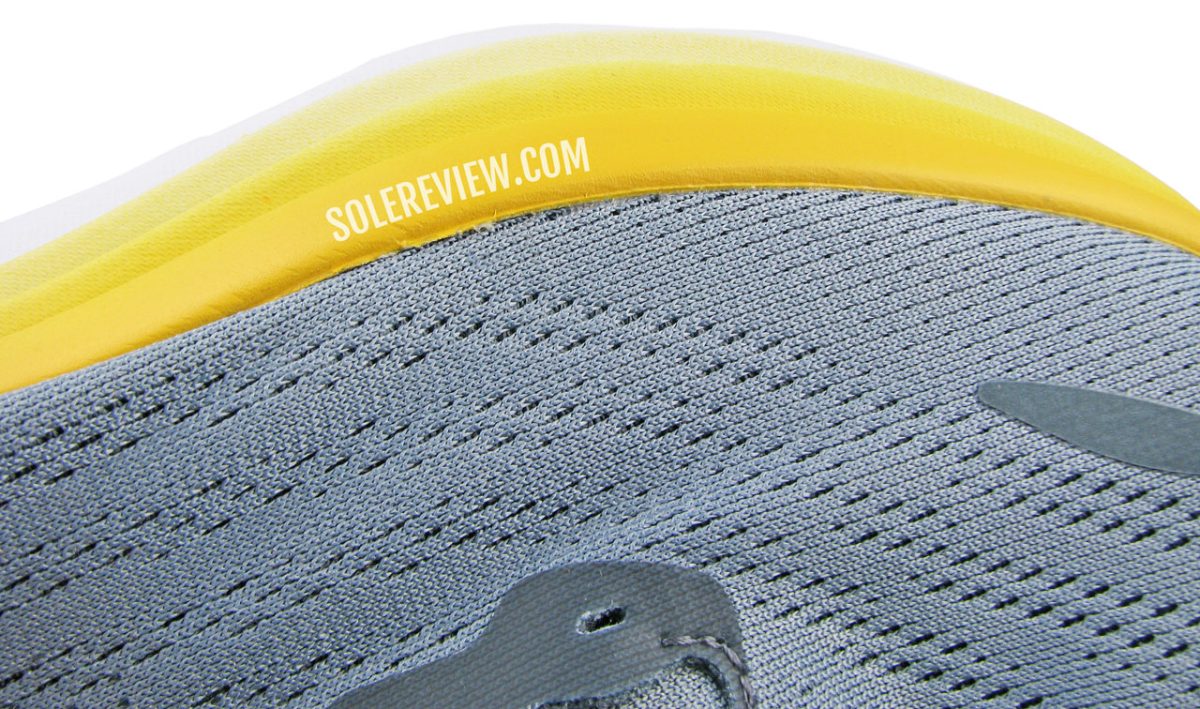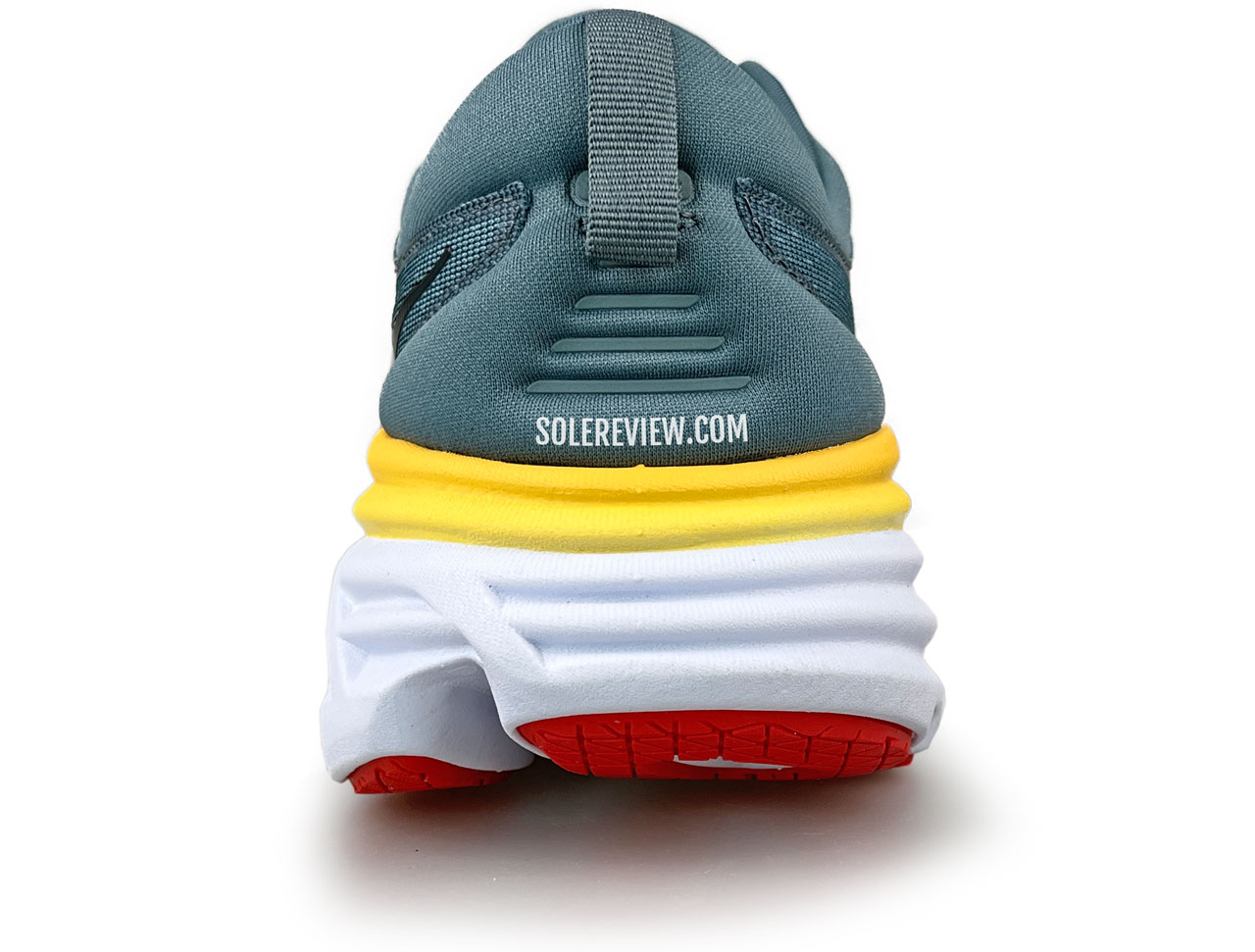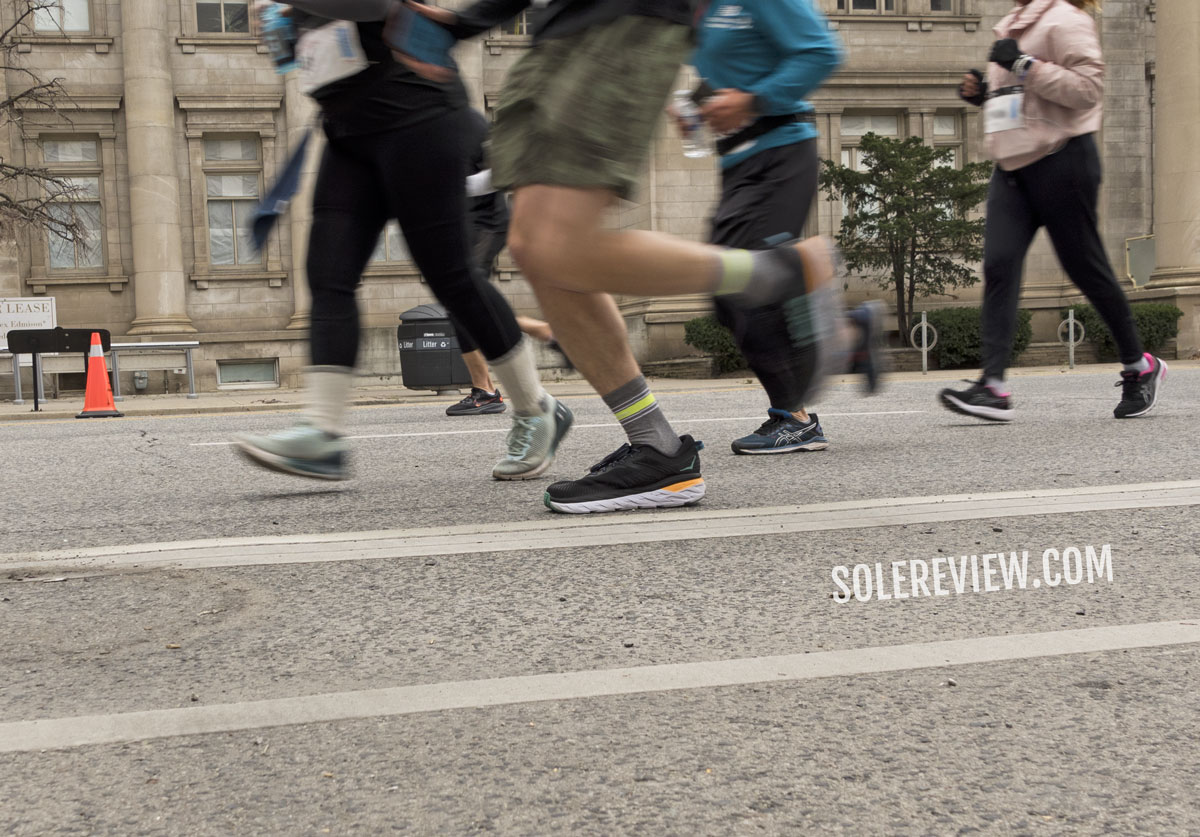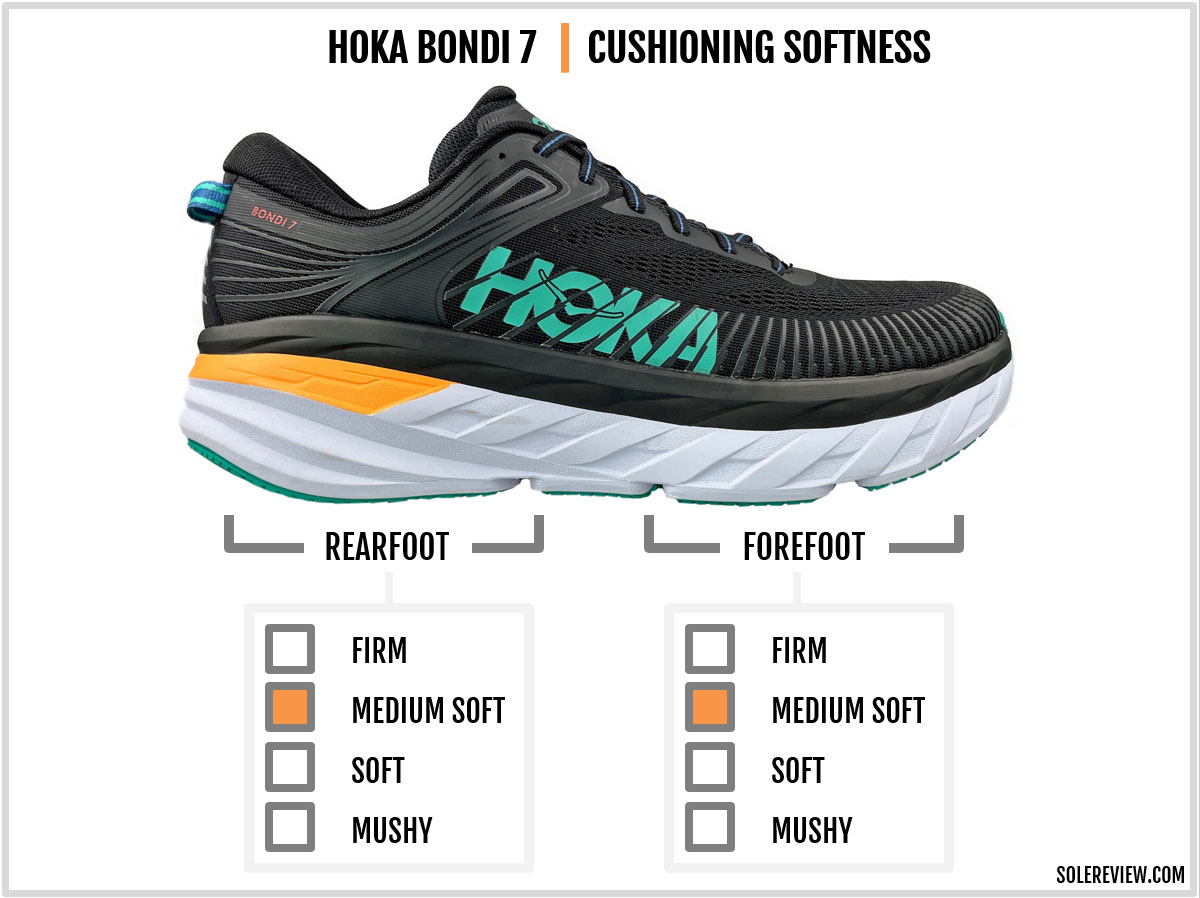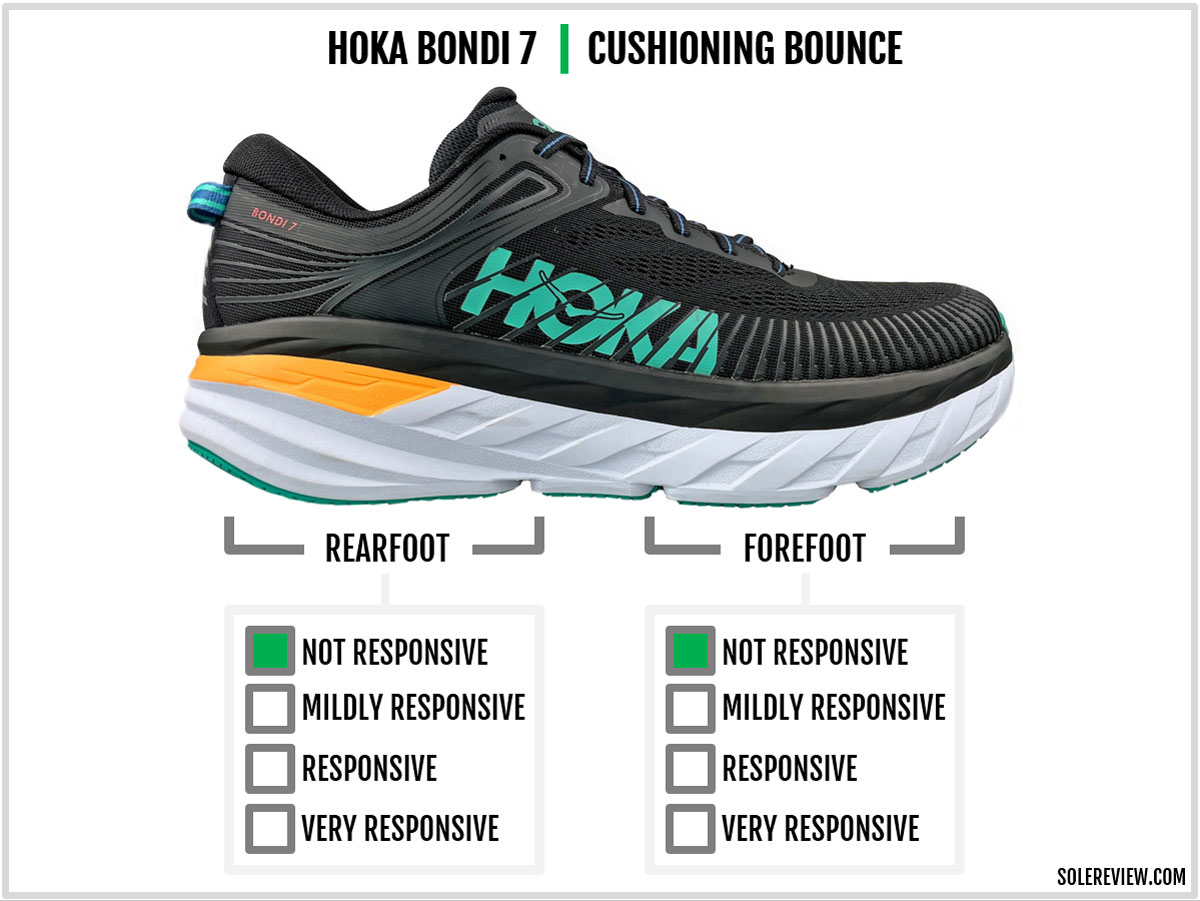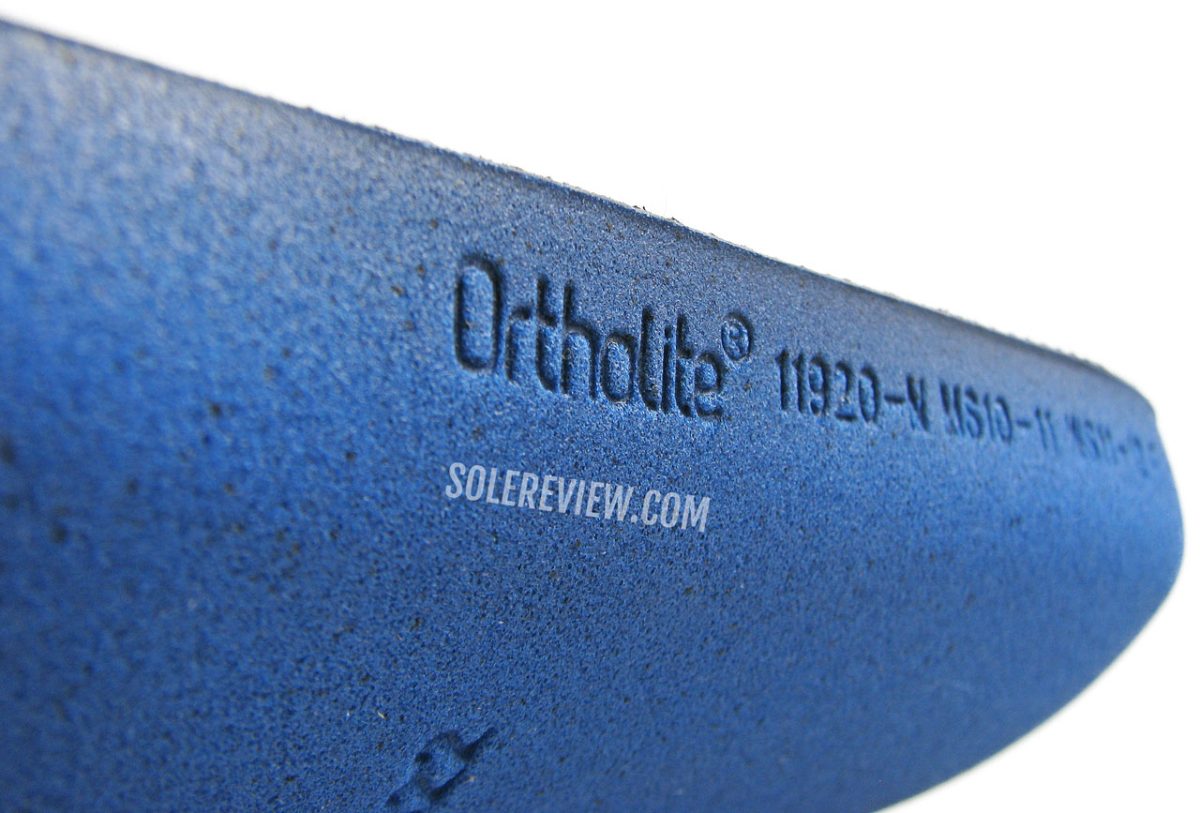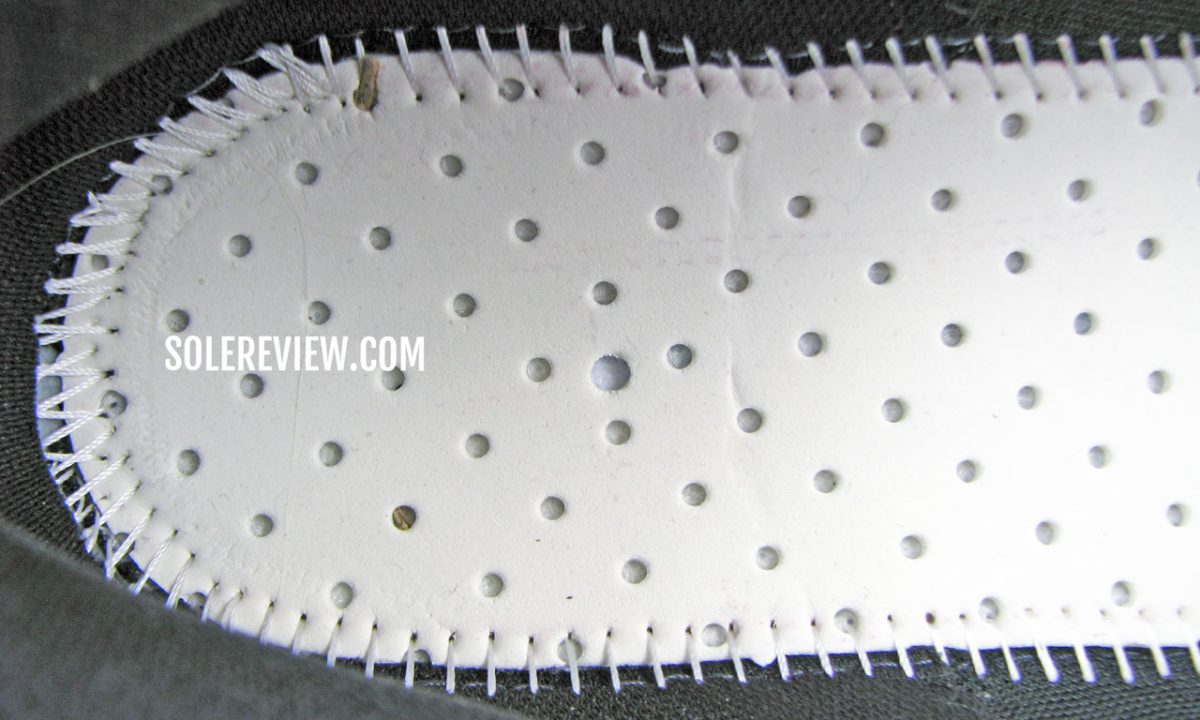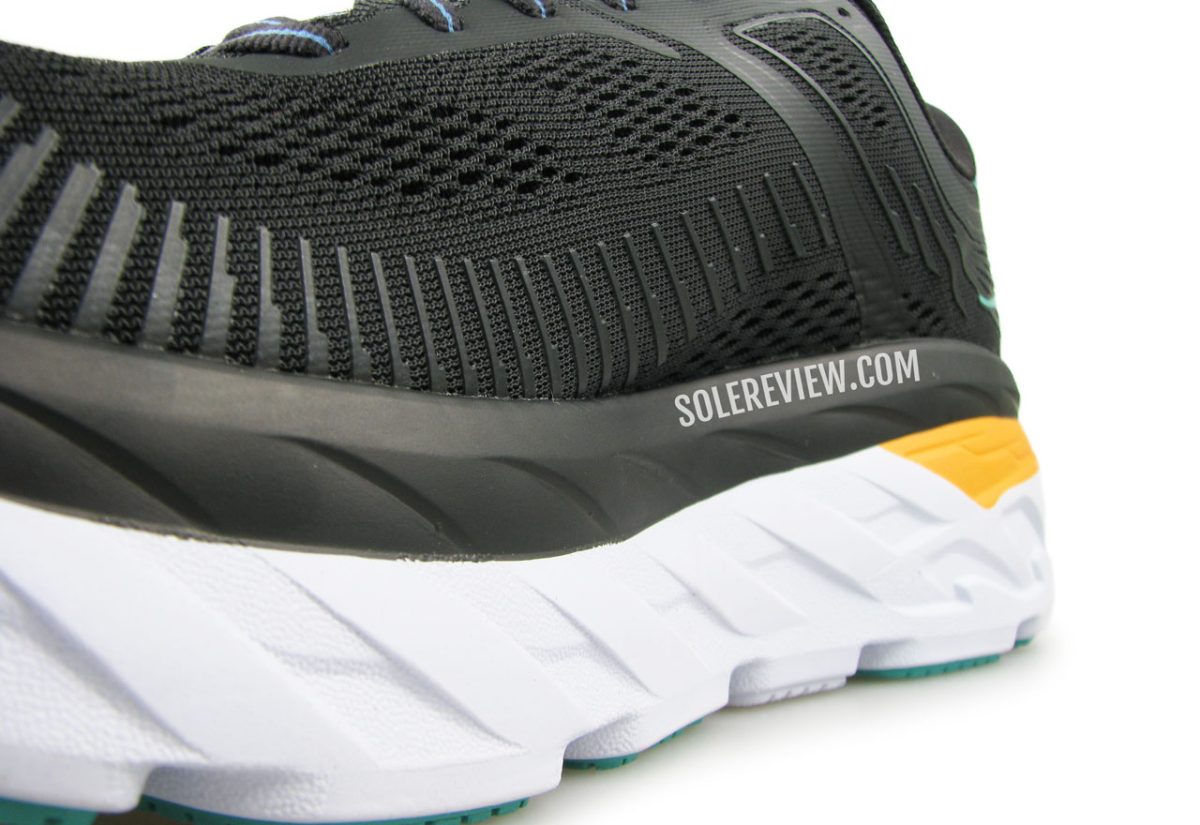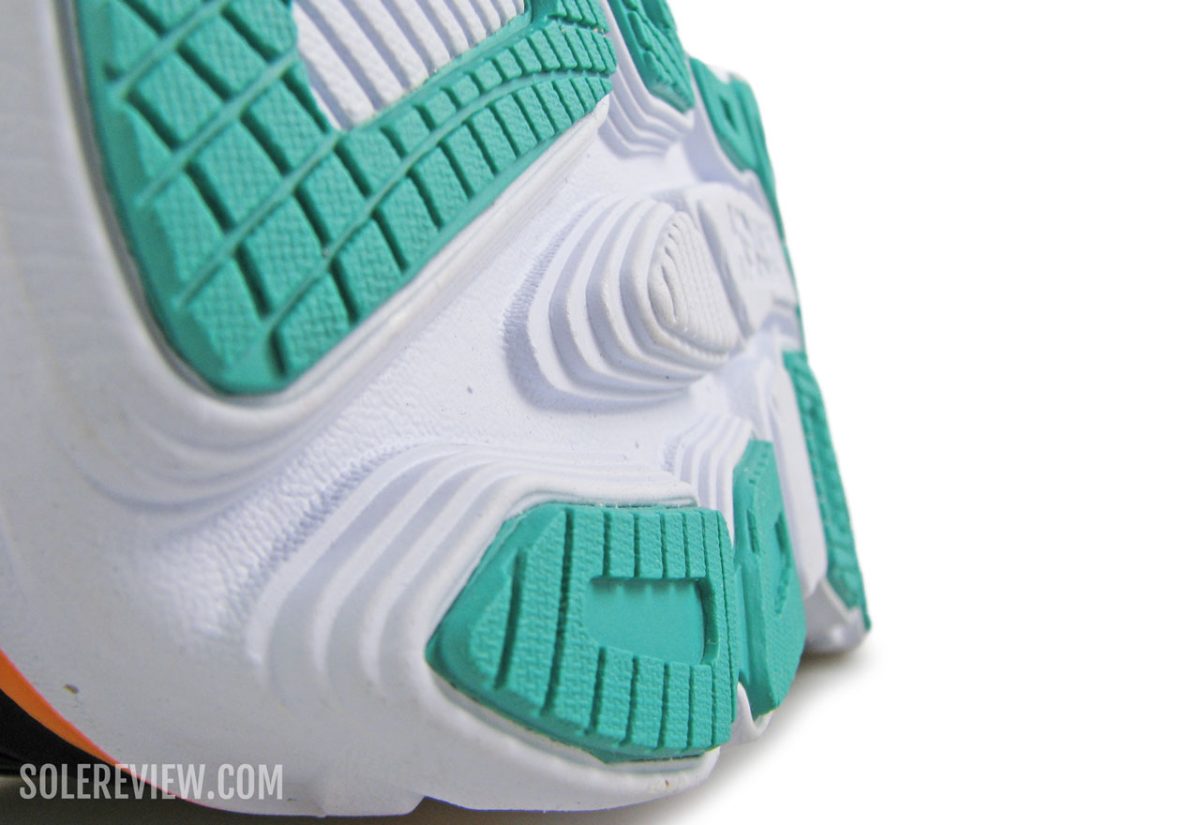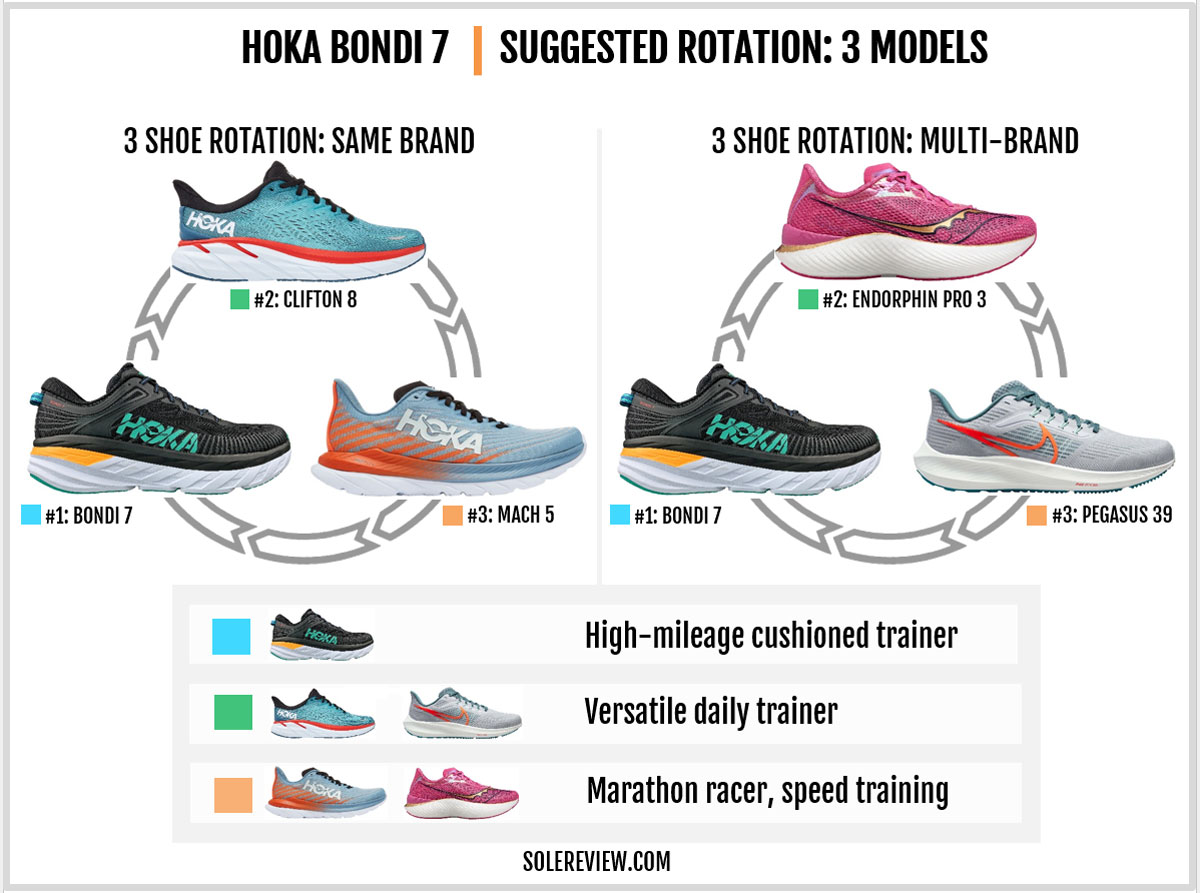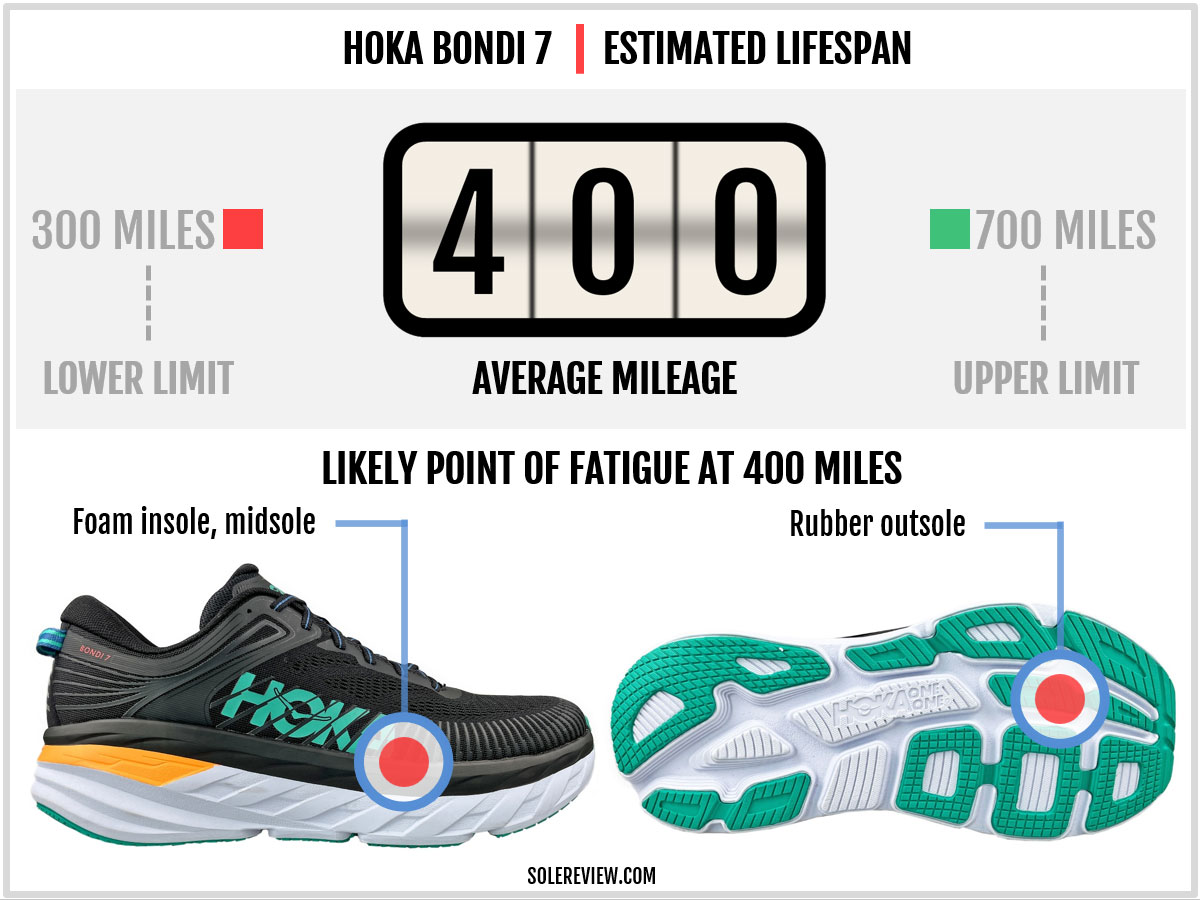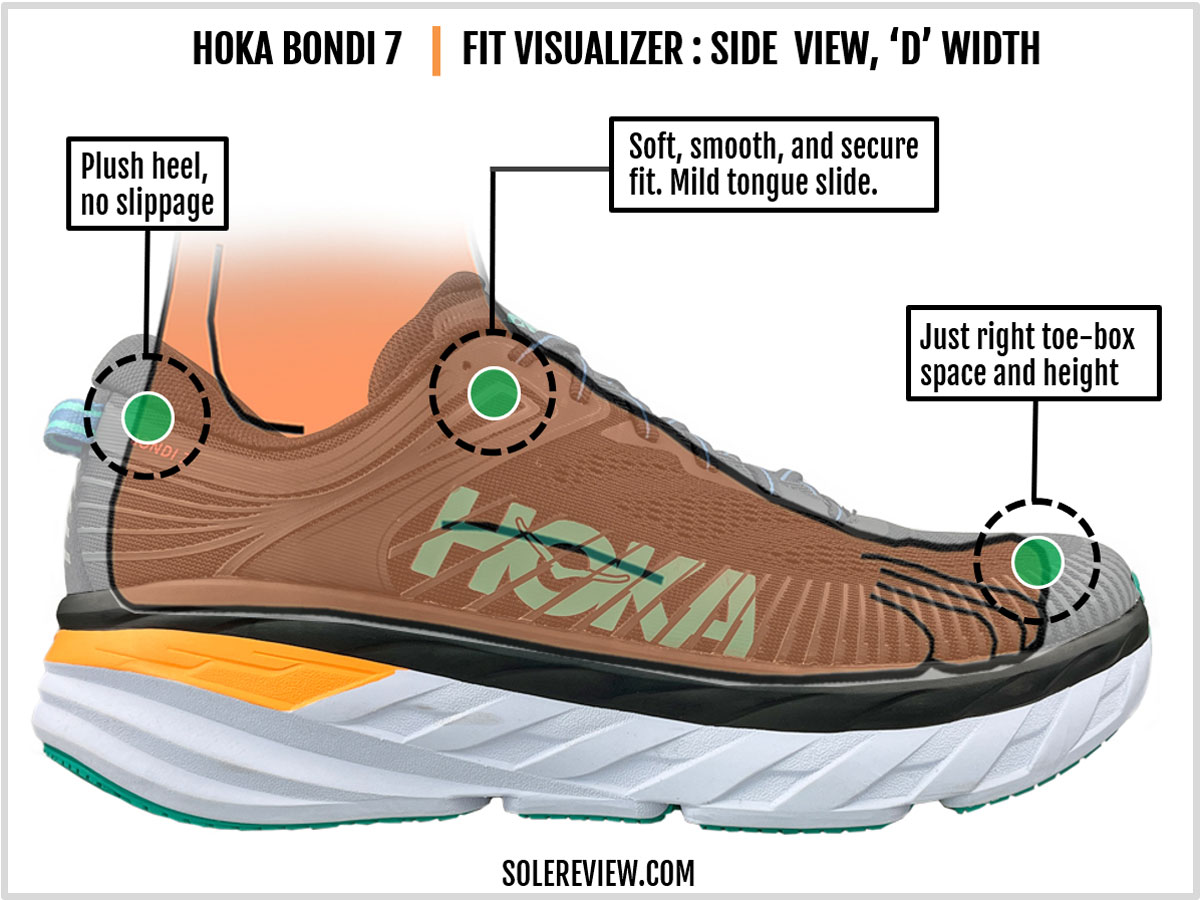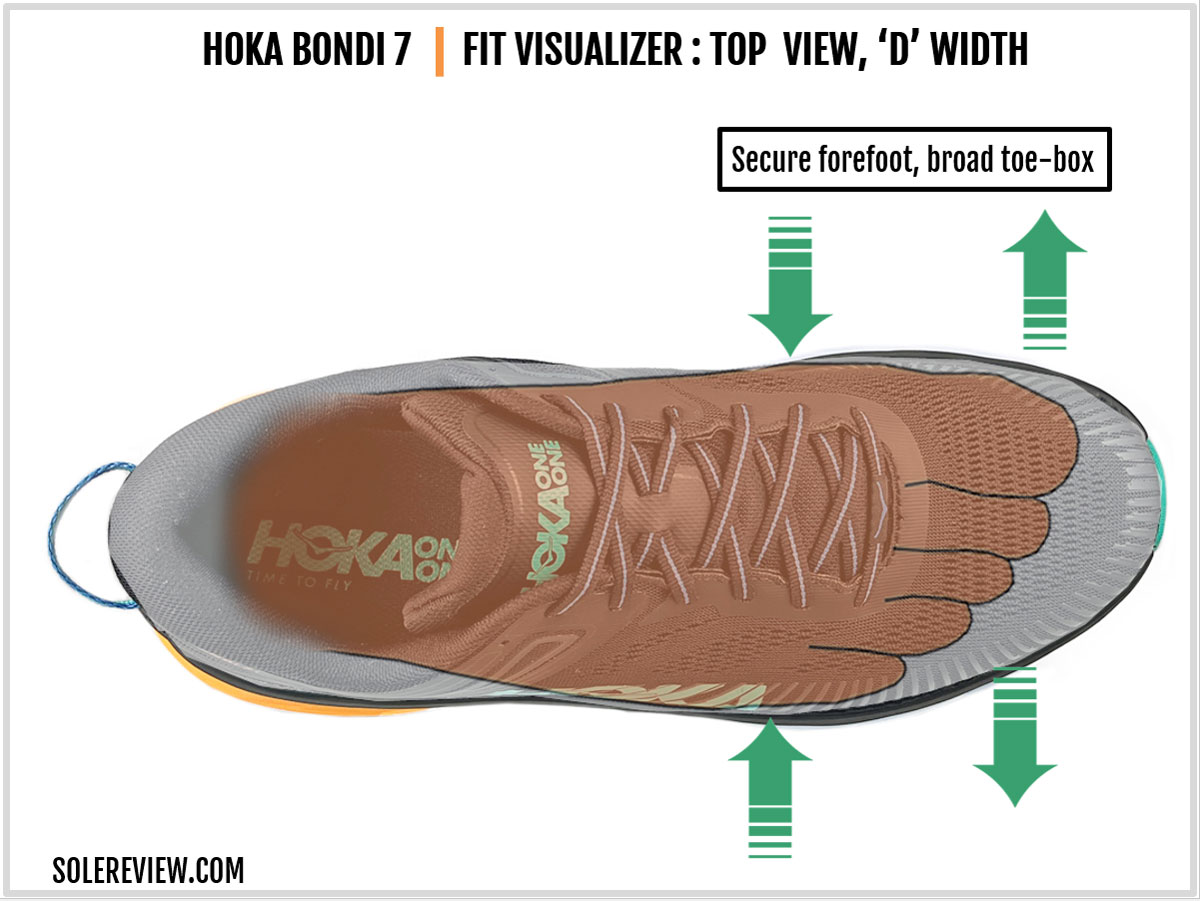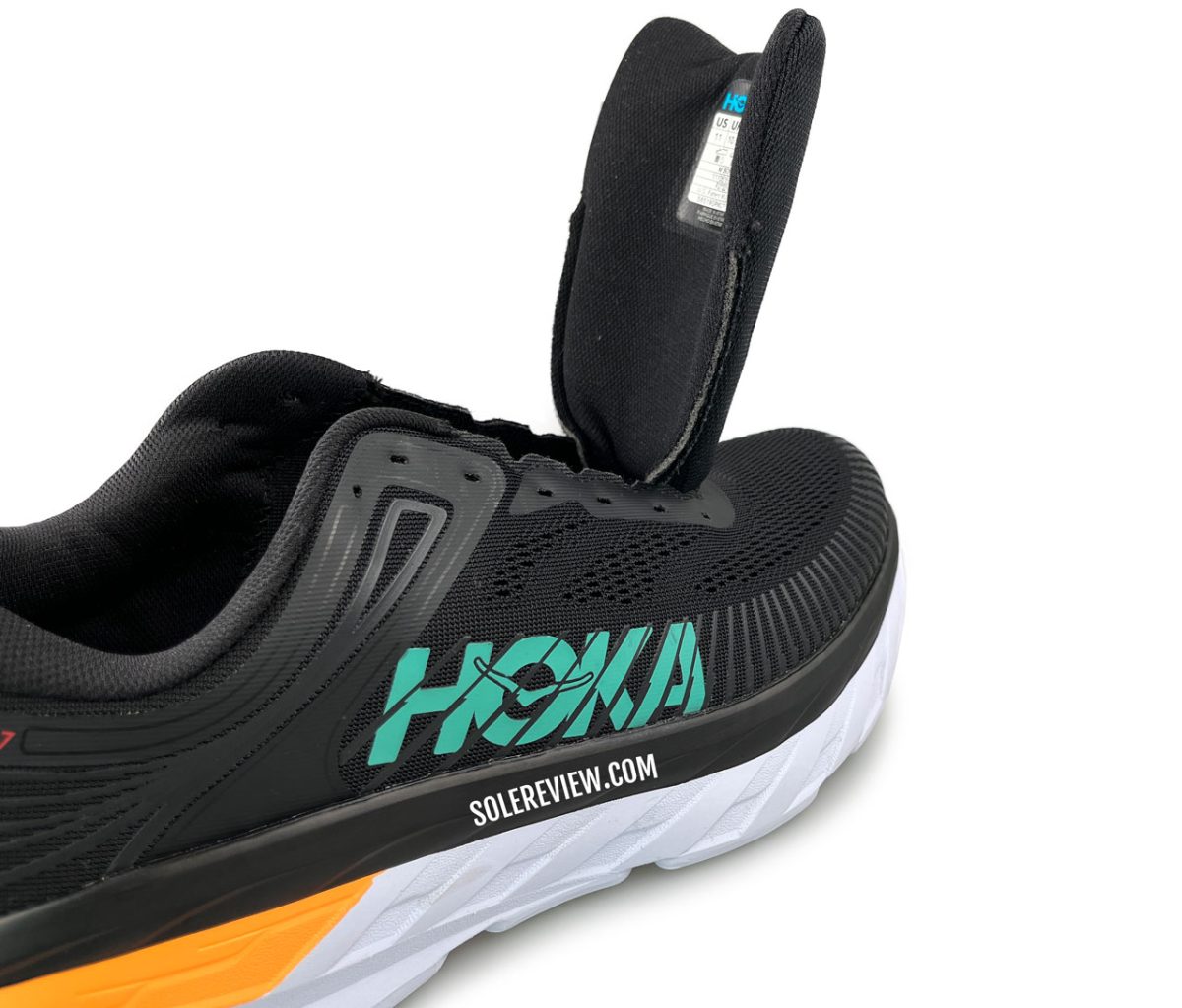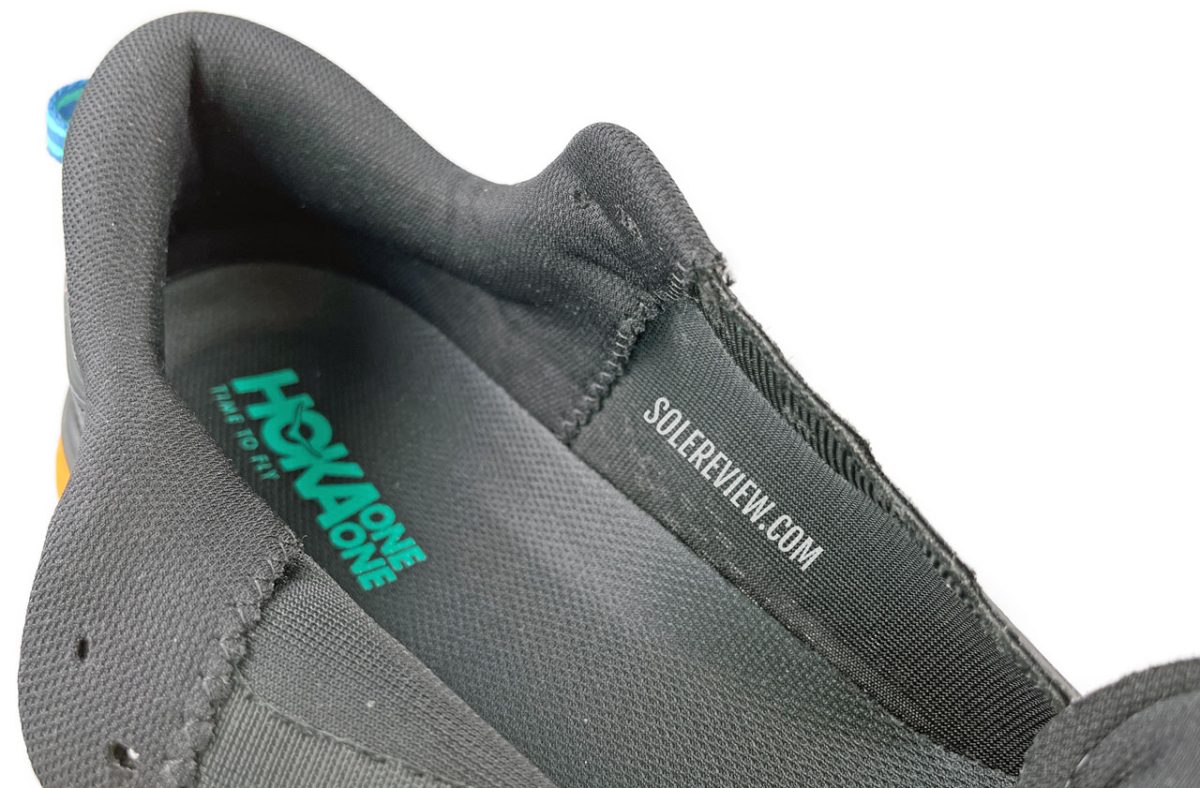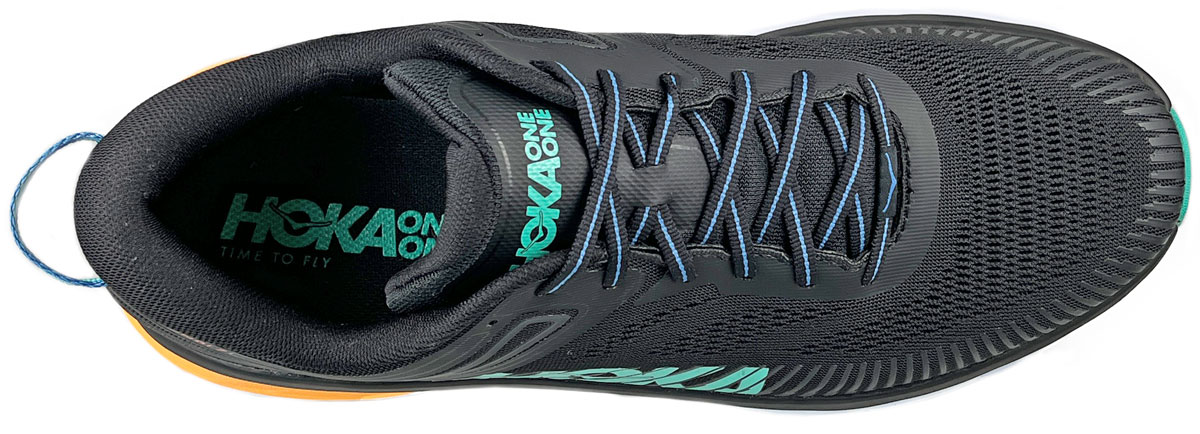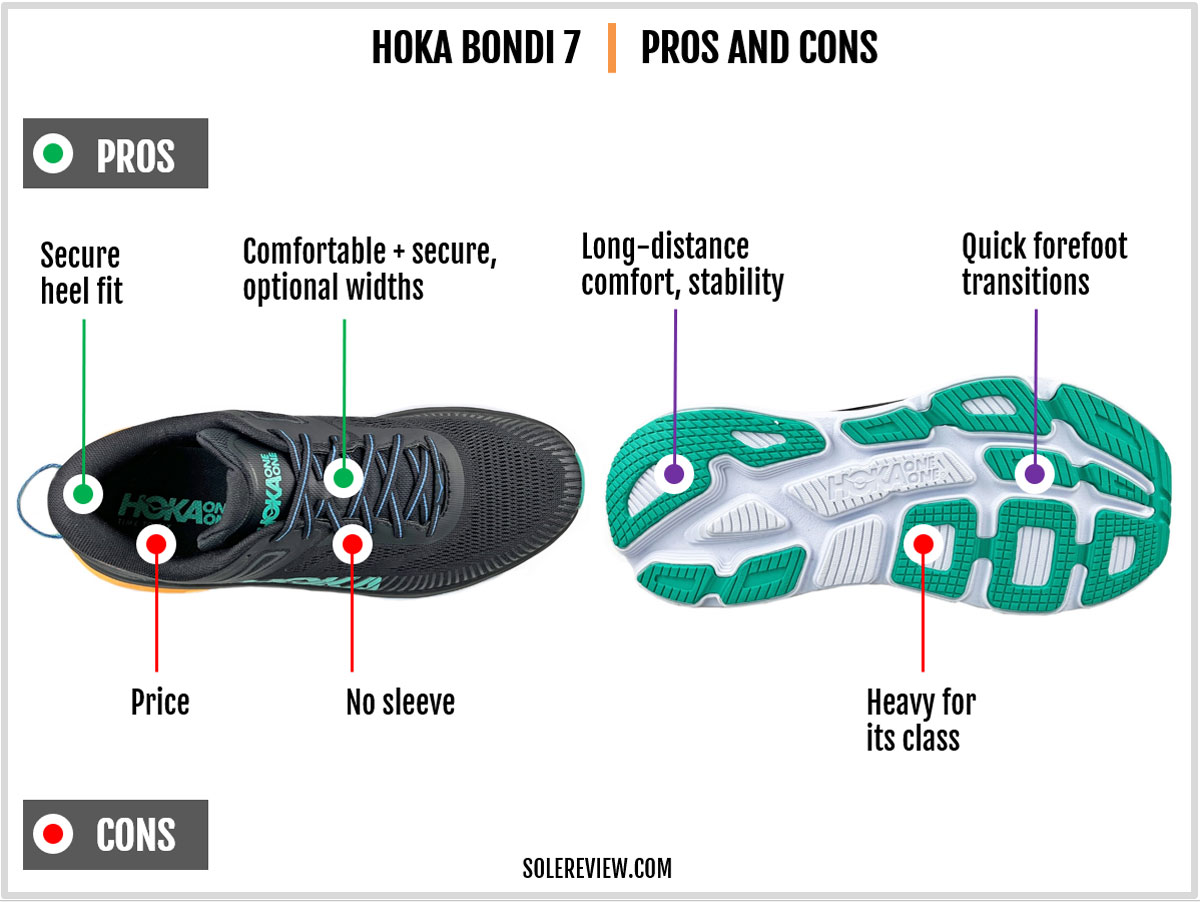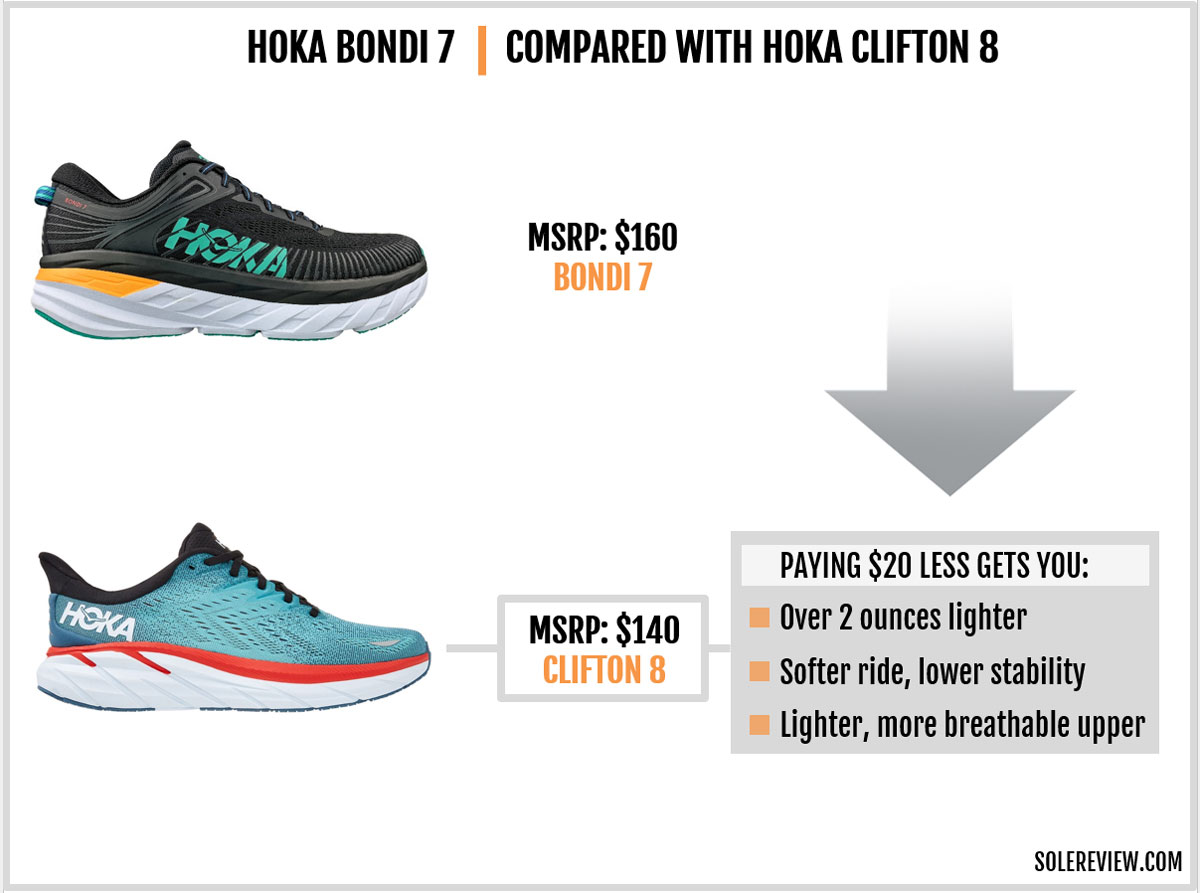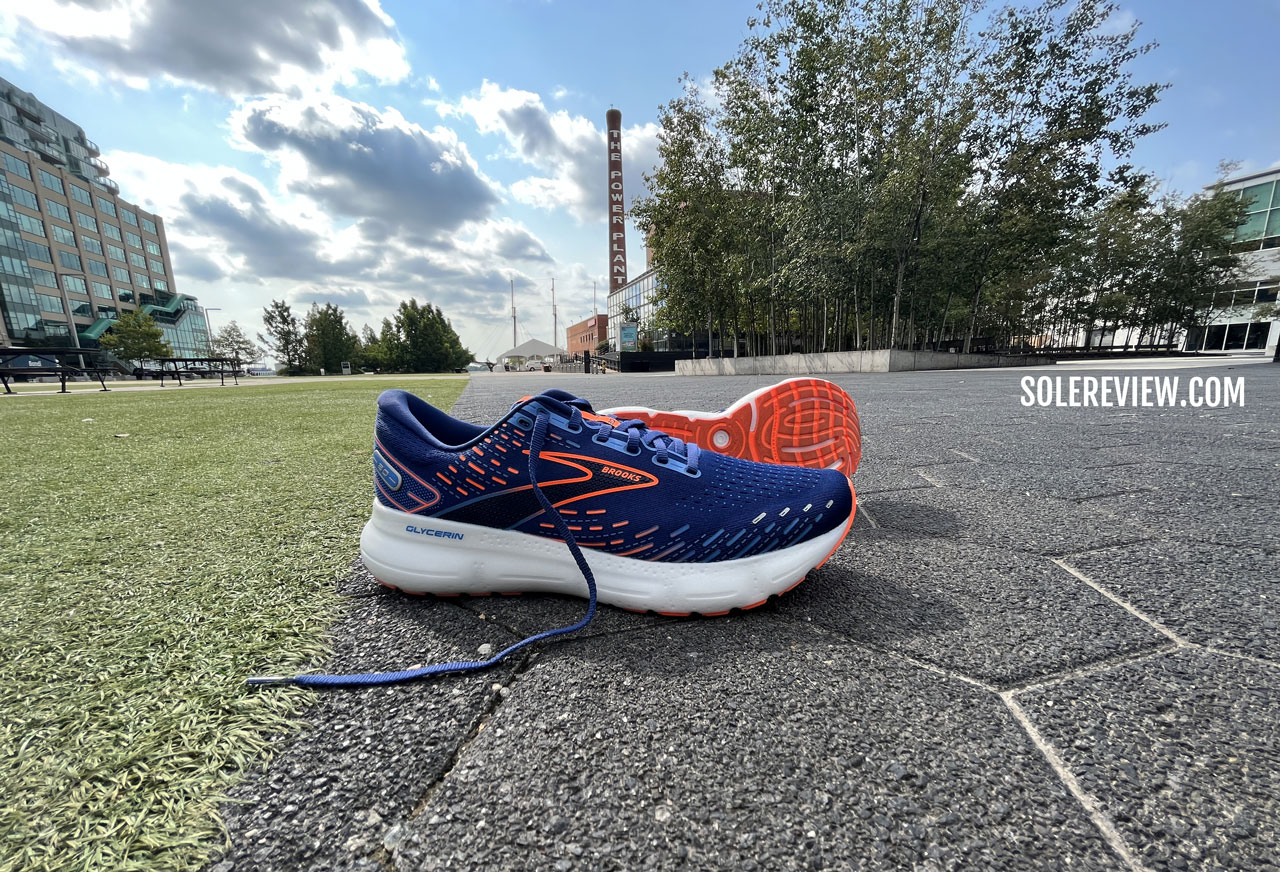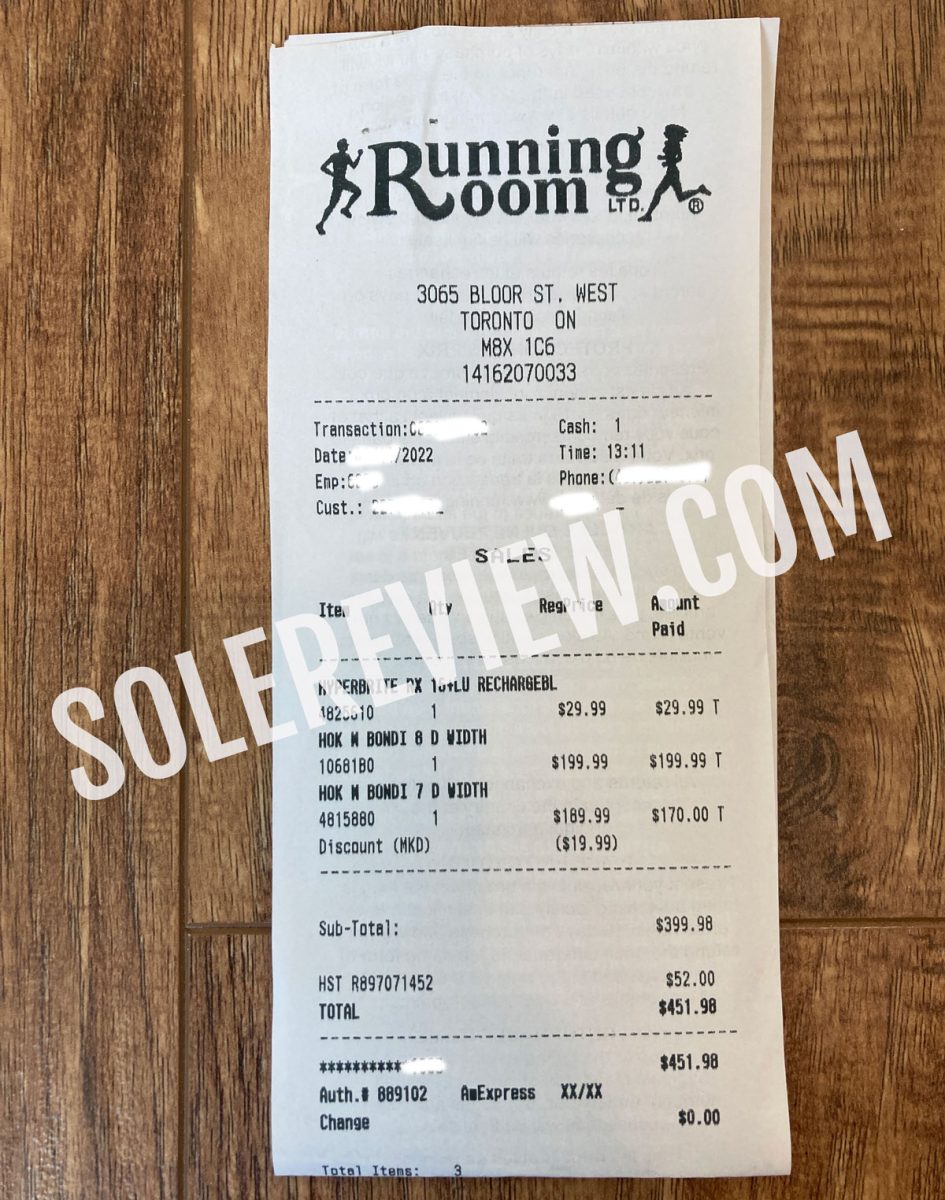
The Hoka Bondi 7 was purchased at full retail price for our review. The amount is in Canadian Dollars.
In this review:
INTRODUCTION
At first, we had no plans to review the Hoka Bondi 7. The Bondi 8 has been out for a few months now, so it makes more sense to review the latest version.
However.
You’re reading a review of the Hoka Bondi 7 because it is a much better running shoe than the mediocre Bondi 8. If you’re planning to buy a Hoka Bondi, we highly recommend that you get the V7 instead.
We’ll get into the how and why of that, but first, let’s discuss the Bondi 7.
If you distill the Hoka Bondi to its essence, the shoe hasn’t changed a lot since we first reviewed the Bondi 4 over seven years ago. Back then, it was the last word in max cushioning.
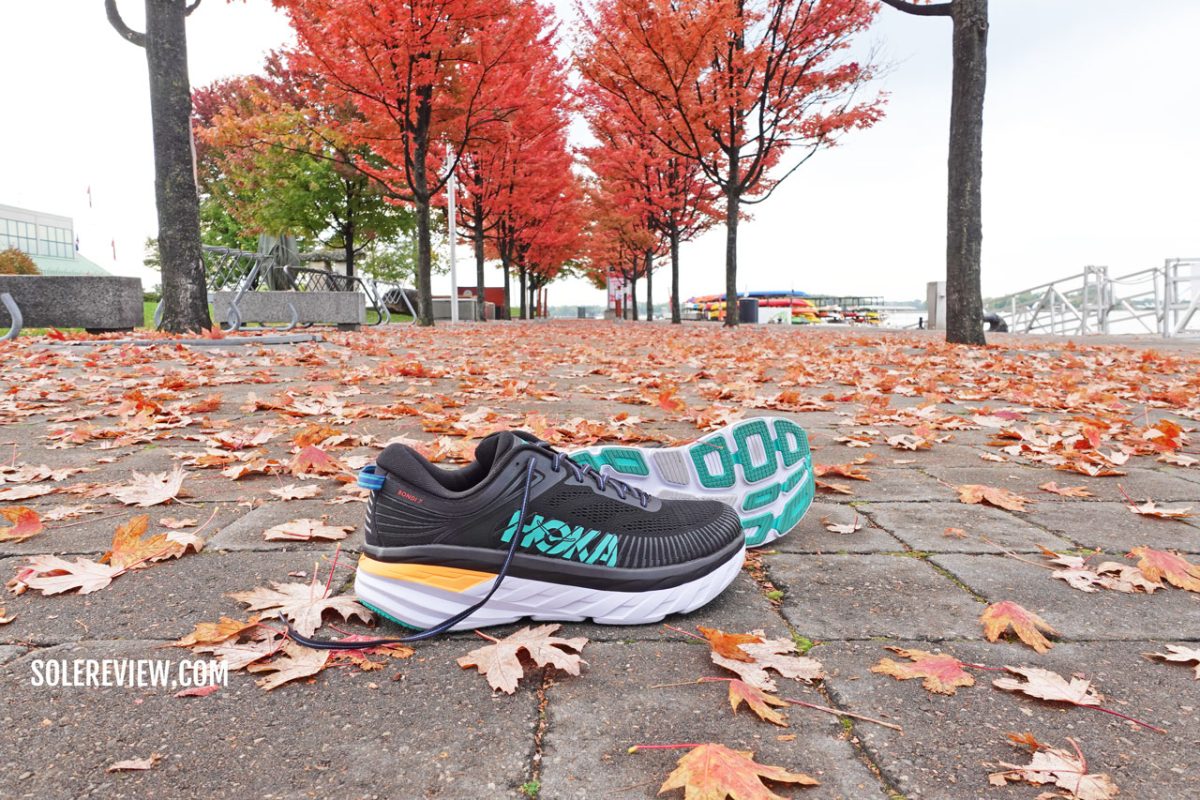
At its core, the Hoka Bondi hasn’t changed. An old-school EVA foam midsole is still the cushioning workhorse.
In 2022, the Hoka Bondi hasn’t changed – if at all – while the world around it looks unrecognizable. Carbon-plated PEBA midsoles and their kind make 2015 running shoes look like Victorian relics.
So given its antiquated specs, why would (or should) anyone buy the Hoka Bondi 7?
The Hoka Bondi 7 weighs over 11 ounces. The EVA midsole is nowhere as responsive as PEBA or Fuelcell. Its $160 sticker is not cheap when technologically superior shoes can be had for the same price. There is no plate for quicker transitions or a bouncier ride. The upper is good, but nothing to write home about.
Many runners buy the Bondi and Clifton for the same reason they get the Asics Cumulus, Brooks Glycerin, and the Brooks Ghost.
The Hoka Bondi is predictable. The EVA midsole delivers a high level of ride comfort without any drama. It’s very supportive for its cushioned ride and is abundantly stocked at most sporting goods retailers.
This is an everyday trainer that is neither too slow nor too fast. It’s a good walking shoe, a casual sneaker (in all white), and a dependable trainer for a 4:00 marathon.
The Bondi 7’s word-of-mouth reputation took a decade to build, so there’s that as well.
Despite its decade-old form factor, the Bondi 7 is still a very useful running shoe. It is also the ultimate generalist sneaker for the masses – much like how the adidas Ultraboost is, but without the edgy design. The Hoka Bondi 7 is also widely used as an everyday walking shoe because of its well-rounded ride character.
THE HOKA BONDI 7 COMPARED WITH HOKA BONDI 8
We usually compare the current model with the previous version, but we’re going to do the opposite here. We’re going to compare the Hoka Bondi 7 with Hoka Bondi 8, and that’s because the 7 is better than the 8.
There are two reasons why we’re not in love with the Hoka Bondi 8. And no, the $5.00 price increase isn’t one of them.
Its new midsole has a stiff edge that creates a pressure hot spot under the foot. We gave the Bondi 8 a few weeks to break in, but the issue persists. The upper is slightly narrower than the Bondi 7, a change that we believe is caused by the redesigned midsole.
Other parts of the Bondi 8 – like the midsole cushioning and stability – are what one would expect.
There’s a high level of ride comfort and stability that’s ideal for long-distance runs. Like the Bondi 7, the Bondi 8’s rocker midsole helps with smooth transitions. The Bondi 8 is firmer under the heel than the 7, but there’s no noticeable difference in the overall ride quality.
The Bondi 8’s upper gets plusher lining materials and a one-sided sleeve, so the underwhelming ride experience is a shame.
THE MIDSOLE DESIGN AND RIDE EXPERIENCE
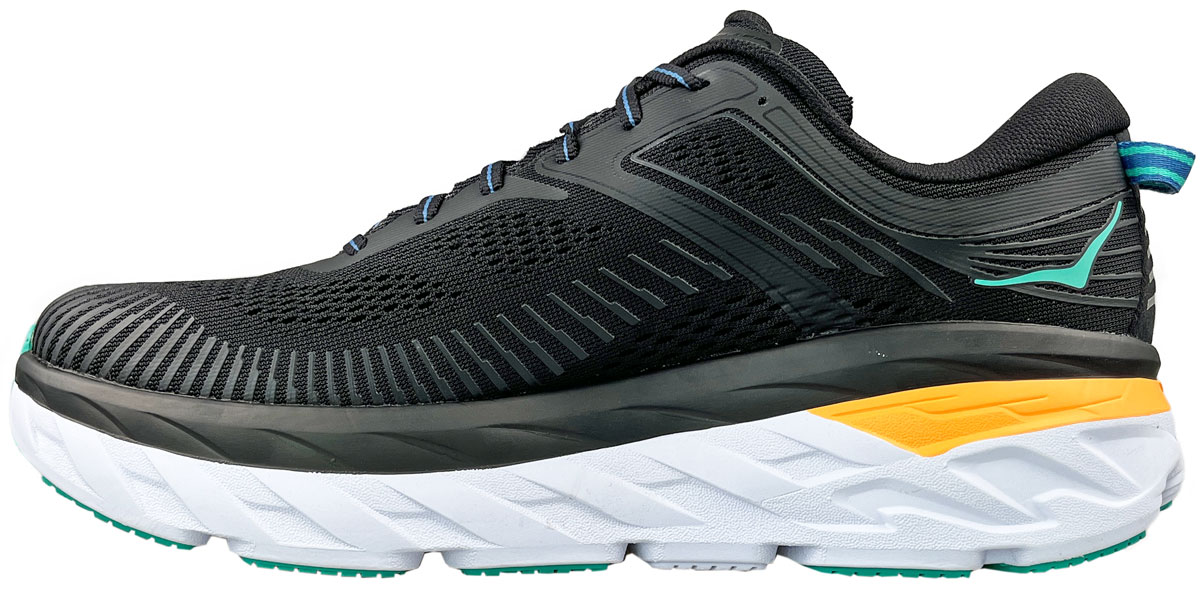
The running shoe landscape has changed, whereas the Bondi 7 is more or less the same. But it’s still great in many ways.
There was a time when the Bondi used to be the gold standard for a ‘max cushioning’ running shoe. This was well before PEBA midsoles and Carbon plates showed up, so there was nothing that came close to the deep cushioning of the Hoka Bondi.
But we’re talking about 2014-15, so what is the Hoka Bondi 7’s place in this new world order?
Earlier this month, we spent many hours taking thousands of photographs at the Toronto marathon. Not counting the popular Carbon-plated shoes like the Nike Vaporfly Next% and Saucony Endorphin Pro 3, we saw a surprisingly high number of running shoes such as the Brooks Glycerin, Asics Novablast, and Hoka Bondi 7.
Even though the Bondi shared the road with the likes of Saucony Endorphin Pro and Nike Vaporfly, there was just one difference. The Bondi 7 was worn by runners who were expected to run a marathon in 4 hours or a half-marathon in around 2 hours. (Note: the racing bib colors provide data on estimated finish times.)
So while the Hoka Bondi 7 is a capable marathon shoe, it serves a different purpose than a Carbon-plated racer.
The 11.4-ounce Hoka Bondi 7 isn’t a speed shoe, but a comfortable trainer for long runs at speeds 5:00 min/km (8 min/mile) or slower. The EVA midsole serves as a deep reservoir of cushioning with high levels of stability.
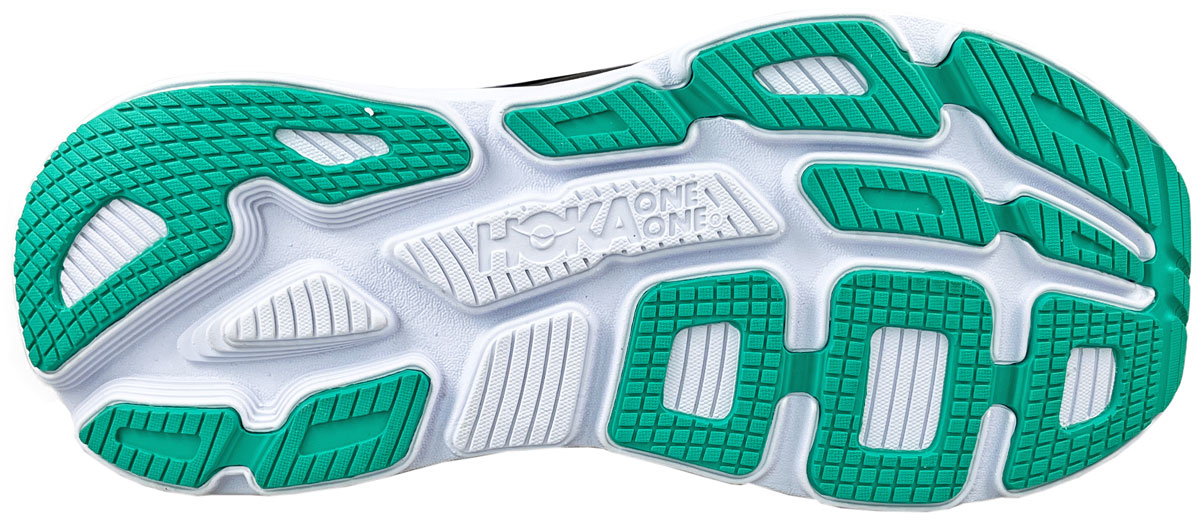
The wide footprint does an excellent job of supporting the bodyweight. The strategically-placed rubber lugs provide the necessary traction.
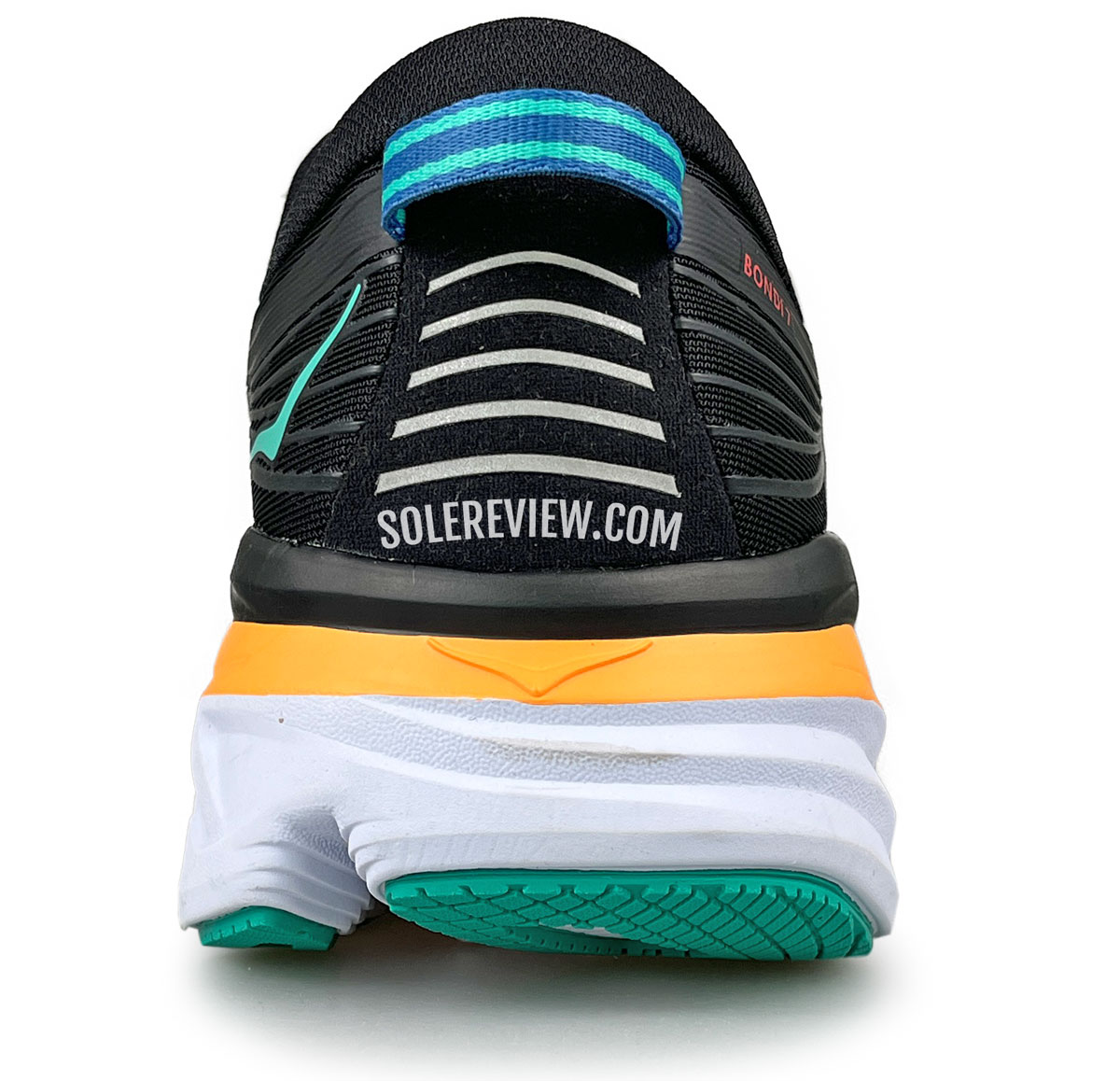
The midsole sidewalls have a balanced design for a neutral ride experience, and the raised edges cup the foot for stability.
The ride stability doesn’t come as a surprise. The wide outsole footprint creates a supportive base throughout its length. The rubber lugs are flush with the foam pods and grip well. The deep flex grooves separate the lugs, so they do a good job of blending into the overall cushioning.
The wide midsole sidewalls also act as stabilizers. Both sides are equally supportive; there’s no cushioning bias here. The raised midsole edges also hold the foot on both sides to lock it in place. The upper has a stiff heel counter, so that helps too.
Hoka uses traditional EVA foam on the Hoka Bondi 7; there’s none of the super-foam stuff here. Using a compression-molded EVA midsole produces a medium-soft ride with a hint of firmness. The overall ride character is very neutral without any correction.
This isn’t a plush or bouncy running shoe by modern standards, so that benefits ride stability.
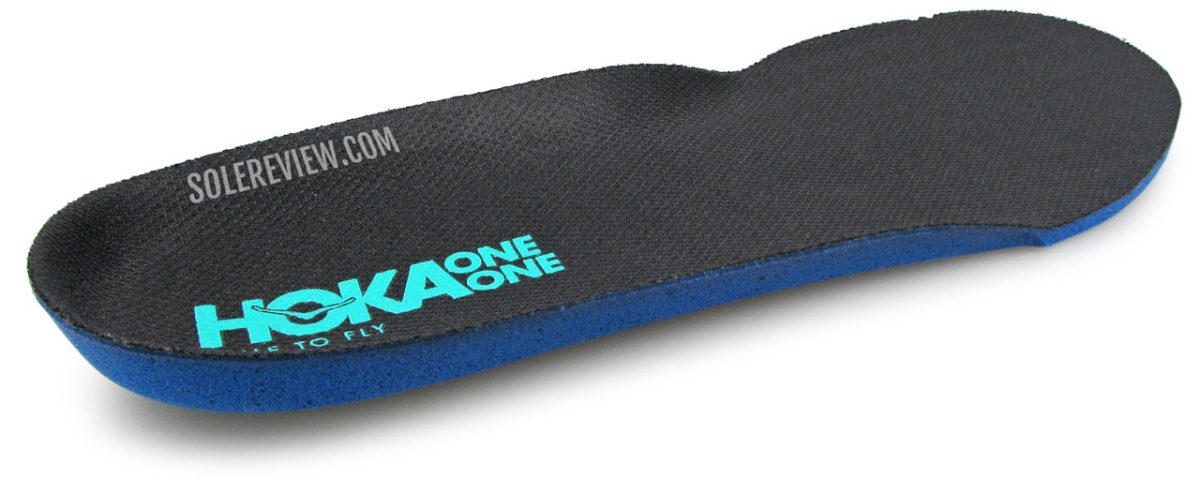
The insole is removable, but thin. If you’re using an orthotic, it’s best to find a matching thickness so that the upper fit isn’t affected.
Though there is a thin Ortholite insole over a perforated foam lasting, most of the cushioning is produced by the thick midsole. By the way, the perforated lasting is a Hoka thing – we first saw it in our 2015 review of the Clifton.
It’s worth bearing in mind that the removable footbed isn’t very thick, so that limits the kind of after-market orthotic you can use. An orthotic that is much thicker than the stock insole will make the fit tighter.
The Bondi has a couple of features that’s specific to Hoka. That would be the low heel-to-toe offset (4 mm in this case) and rocker forefoot.
A rocker midsole means that the forefoot isn’t flexible, and the front portion of the midsole has a steep upwards curve. This is also called the toe-spring, a feature that helps the foot ‘roll’ forward.
Hoka isn’t the only shoe with this kind of design. Notable examples would be the Asics Novablast, Glideride, and the Saucony Endorphin Pro/Speed/Shift.
The firm forefoot and high toe-spring help the Bondi 7 power through the transitions smoothly.
The forefoot turnover is relatively quick for a shoe of this class, and that’s one of the reasons why this works as a marathon shoe.
The balanced and smooth ride makes it easy to settle into a consistent pace/cadence during a run. The low heel-to-toe drop and wide footprint make the Hoka Bondi 7 ideal for heel and forefoot strikers alike.
What works for long-distance runs like a marathon (or half) also translates well into everyday use. The cushioned and stable ride is good for medium-paced (5:00 min/km, 8:00 min/mile) training.
RECOMMENDED ROTATION
A three-shoe rotation using just Hoka feels unnecessary; just two shoes will get the job done.
The Hoka Mach 5 is a comfortable and lightweight running shoe for speed training and 5K/10K races, and the Bondi 7 is your long-distance cruiser.
We don’t see the Rincon’s value proposition if you already own the Mach 5 (or 4). It’s a better idea to get the Hoka Clifton 8 if you want a ‘bridge’ between the Mach 5 and Bondi 7. But frankly, just two Hoka shoes in the rotation will serve most of your needs.
If you have a larger budget, we recommend the Saucony Endorphin Pro 3 as a marathon racer and the Nike Pegasus 39 as a quicker everyday trainer to go along with the Bondi 7.
IS THE HOKA BONDI 7 DURABLE?
The Bondi 7’s traditional design includes a compression-molded EVA midsole with outsole rubber where necessary. The foam isn’t very soft, it will retain most of its cushioning over a few hundred kilometers.
The thick spacer mesh upper is reinforced near the midsole edge to prevent wear and tear. A lifespan of 400 miles is easily doable, with the potential for much higher mileage.
THE UPPER DESIGN AND FIT
Seeing the changed fit of the Bondi 8, we will miss the nicely-proportioned fit of the Bondi 7.
The Hoka Bondi 7’s upper fit true-to-size, and the comfortable interiors have a soft and smooth feel that’s also secure. The spacer mesh has built-in sponginess and also breathes well.
The tongue and heel collar have a generous fill of foam, and the textile lining has a soft hand feel.
A stiff counter locks the heel over the supportive midsole, so there’s no slippage at all – even without using the last eyelet for a runner’s loop.
The large size of the heel loop makes it fully functional; a column of reflective strips is printed over the heel.
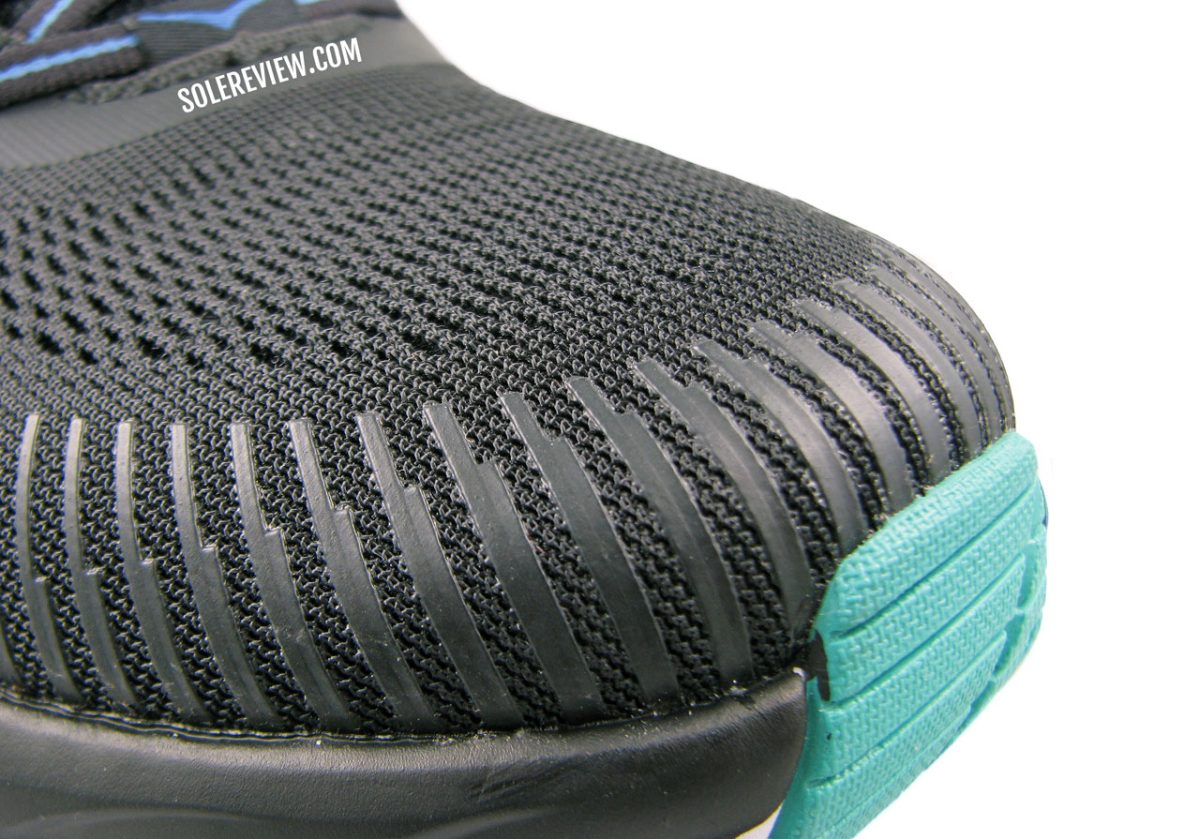
The broad toe-box has an accommodating fit profile. The rubberized overlays add some splash resistance when running on damp roads.
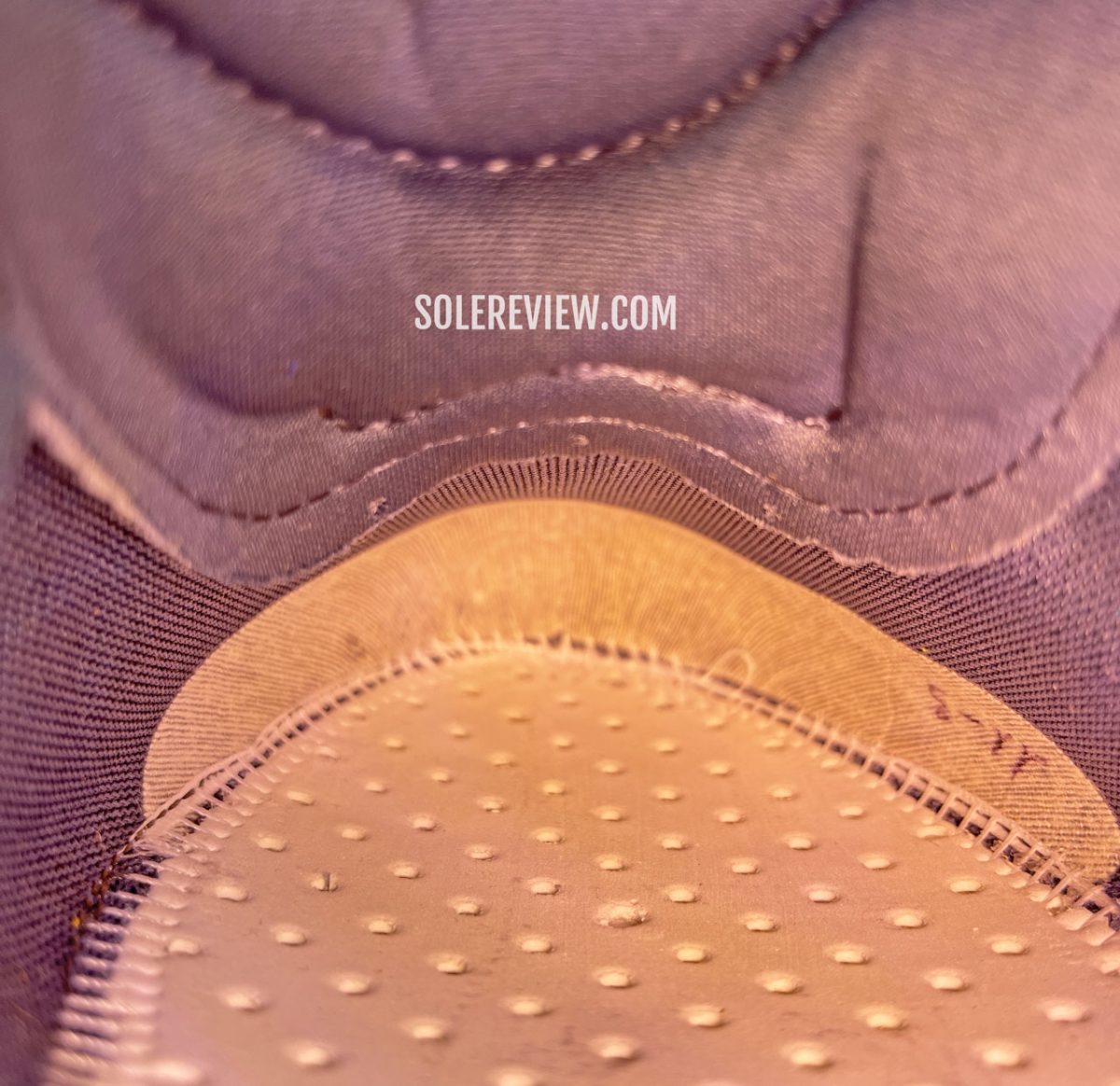
The upper does a fine balancing act between interior space and fit security. The ventilation isn’t bad either.
While this shoe is offered in optional wide (2E) and extra-wide (4E) fits, the standard width has a just-right fit that will accommodate most runners.
The toe-box is spacious – both vertically and horizontally. The secure forefoot never feels narrow, and there are no hot spots.
PROS AND CONS
Except for runs that are quicker than 5:00 min/km (8:00 min/mile), the Bondi 7 is good at everything else.
The comfortable and supportive ride makes this shoe an excellent daily trainer as well as a long-distance shoe. At over 11 ounces, it’s not the lightest of the lot, but it offers a balanced ride quality that works for most runners.
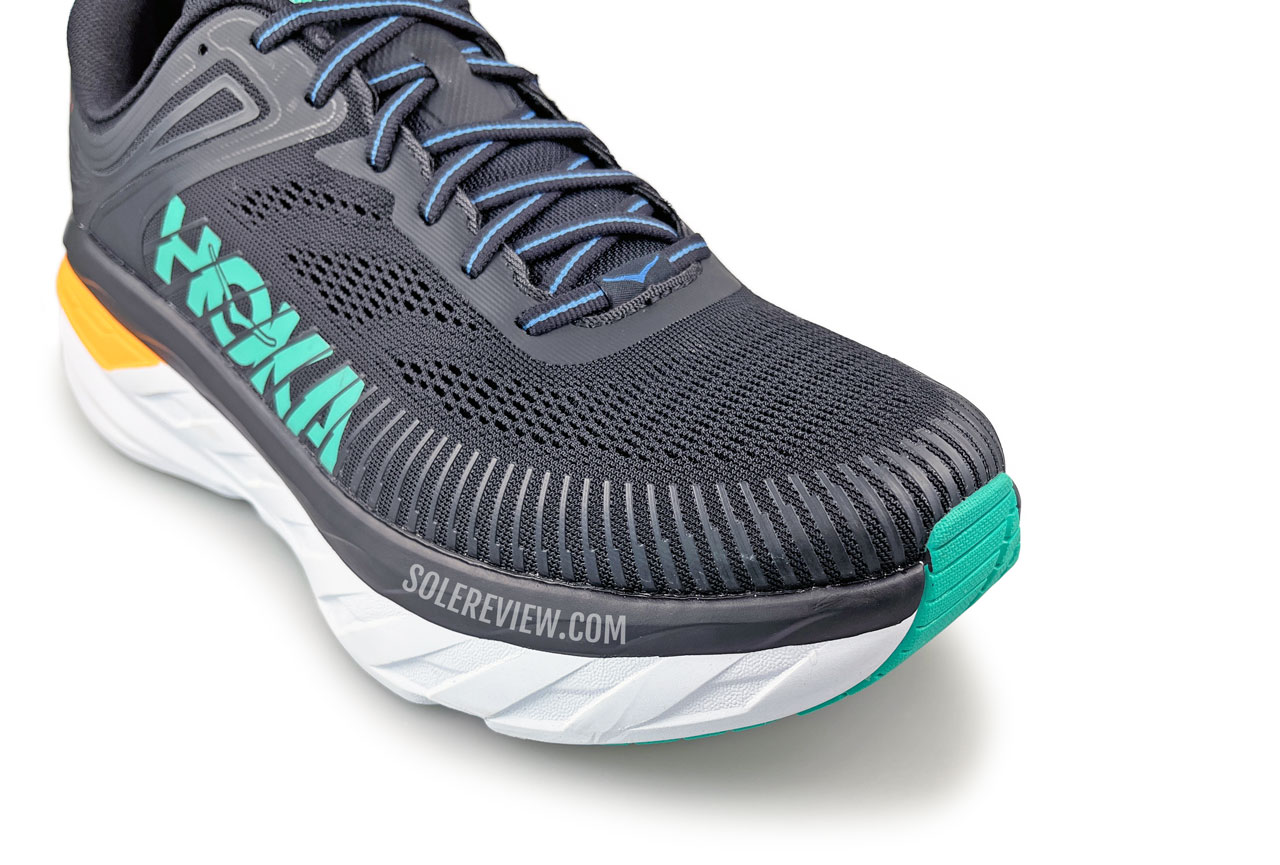
If the well-proportioned upper fit wasn’t good enough, the Hoka Bondi 7 is also available in a wide and extra wide.
We love the upper fit. It hits the Goldilocks zone between a secure fit and interior comfort, and there are multiple widths available. The spongy spacer mesh feels soft over the foot and breathes well.
The $160 (now $165 for the Bondi 8) isn’t great value for money, considering that the Hoka Bondi 7 uses an ordinary EVA foam midsole. For example, even though the Saucony Endorphin Speed 2 was from a different category, it offered a PEBA midsole with a Nylon plate for the same price.
COMPARISON: THE HOKA BONDI 7 VERSUS HOKA CLIFTON 8
At 8.9 ounces, the $20 cheaper Clifton 8 is noticeably lighter than the Bondi 7. It’s also softer and lighter, so that means that the Clifton performs better at higher speeds (quicker than 5:00 min/km or 8:00 min/mile). There’s a pep in the ride that makes the rocker forefoot more fun.
While the Clifton 8 doesn’t feel as solid-footed as the Bondi, it’s fairly supportive.
Like the latter, the raised midsole walls cup the foot for support, and there’s plenty of cushioning under the foot. The Clifton 8 is a versatile daily trainer while being perfectly capable of half-marathons and farther.
SHOES SIMILAR TO THE HOKA BONDI 7
We view the Brooks Glycerin 20 as the closest match to the Hoka Bondi 7. Of course, the Glycerin is based on a very different cushioning platform, and the foam feels nothing like the Bondi’s EVA foam stack.
However, based on the use case, the Glycerin 20 targets the same consumer that the Bondi does. Both shoes are heavy by modern standards.
Both have a cushioned ride with high levels of stability. And you can run a marathon in the Brooks shoe as well. The uppers are equally plush, and the retail price is identical. That said, the Brooks Glycerin 20 is an ounce lighter than the Bondi 7, and the 10 mm heel offset is higher.
For a softer ride, the Mizuno Wave Sky 6 is worth considering. On the far end of the softness spectrum is the Nike ZoomX Invincible Run 2, but the ride isn’t as stable as the Bondi.
The Saucony Triumph 20 offers a performance-oriented (quicker) cushioning, whereas the adidas Ultraboost 22 is your do-it-all sneaker.
Do you own this shoe? Improve this review by sharing your insights – submit a review here.

